What To Know About Medicinal Herbal Juices
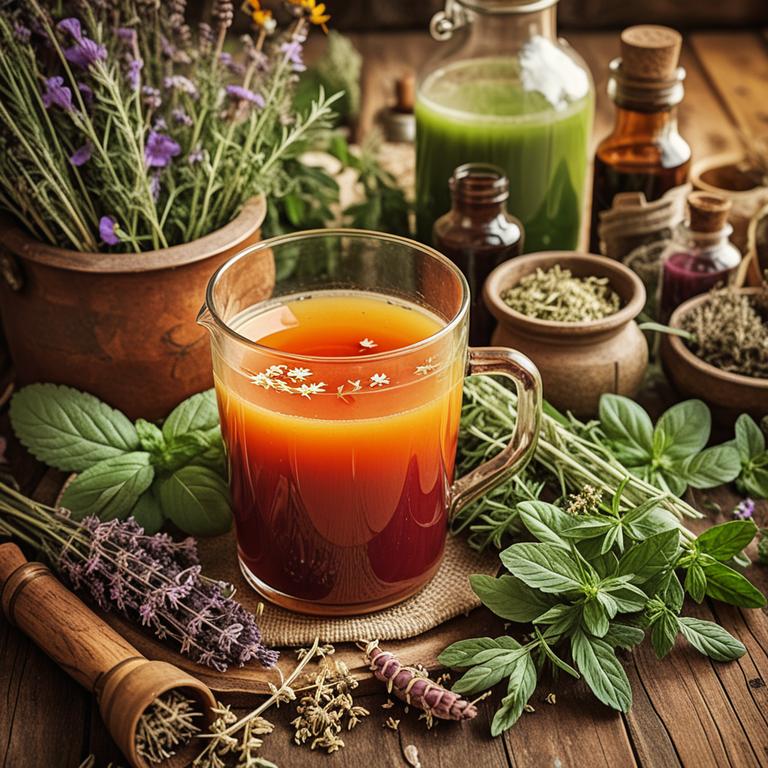
Some of the best medicinal herbal juices include turmeric juice, which is renowned for its anti-inflammatory and antioxidant properties due to its active compound, curcumin.
Ginger juice is another powerful option, known for aiding digestion, reducing nausea, and boosting immunity. Lemon juice, rich in vitamin C, supports immune function and detoxifies the body. Holy basil (tulsi) juice is valued in Ayurveda for its ability to reduce stress and promote mental clarity.
Additionally, carrot juice is packed with beta-carotene and other nutrients that support eye health and overall wellness.
FREE Herb Drying Checklist
How to make sure every batch retains maximum flavor, color, and aroma without the risk of mold or over-drying. Eliminate guesswork and trial-and-error, making herb drying faster, easier, and more efficient every time.
Table of Contents
- 1. Urtica dioica
- 2. Zingiber officinale
- 3. Vitex agnus-castus
- 4. Silybum marianum
- 5. Curcuma longa
- 6. Rosa canina
- 7. Salvia officinalis
- 8. Glycyrrhiza glabra
- 9. Cnicus benedictus
- 10. Echinacea purpurea
- 11. Piper nigrum
- 12. Mentha piperita
- 13. Rosmarinus officinalis
- 14. Aloe barbadensis
- 15. Cuminum cyminum
- 16. Foeniculum vulgare
- 17. Vitis vinifera
- 18. Lavandula angustifolia
- 19. Achillea millefolium
- 20. Hypericum perforatum
- 21. Cinnamomum verum
- 22. Nigella sativa
- 23. Equisetum arvense
- 24. Nymphaea alba
- 25. Cinnamomum zeylanicum
- 26. Thymus vulgaris
- 27. Matricaria chamomilla
- 28. Ginkgo biloba
- 29. Camellia sinensis
- 30. Chamomilla recutita
- 31. Pimpinella anisum
- 32. Petroselinum crispum
- 33. Prunus domestica
- 34. Artemisia absinthium
- 35. Cymbopogon citratus
- 36. Sambucus nigra
- 37. Allium sativum
- 38. Sabadilla tinctura
- 39. Sanguinaria canadensis
- 40. Centella asiatica
- 41. Eucalyptus globulus
- 42. Nelumbo nucifera
- 43. Melissa officinalis
- 44. Pelargonium graveolens
- 45. Lepidium meyenii
- 46. Sanguisorba officinalis
- 47. Satureja hortensis
- 48. Moringa oleifera
- 49. Nepeta cataria
- 50. Sutherlandia frutescens
- 51. Tribulus terrestris
- 52. Panax ginseng
- 53. Hydrastis canadensis
- 54. Triticum aestivum
- 55. Agrimonia eupatoria
- 56. Calendula officinalis
- 57. Tamarindus indica
- 58. Leonurus cardiaca
- 59. Echinacea angustifolia
- 60. Artemisia vulgaris
- 61. Vaccinium myrtillus
- 62. Boswellia serrata
- 63. Rhodiola rosea
- 64. Taraxacum officinale
- 65. Valeriana officinalis
- 66. Vitex negundo
- 67. Ocimum basilicum
- 68. Plantago lanceolata
- 69. Symphytum officinale
- 70. Paeonia suffruticosa
- 71. Artemisia annua
- 72. Cyperus rotundus
- 73. Ocimum sanctum
- 74. Avena sativa
- 75. Cymbopogon martinii
- 76. Anethum graveolens
- 77. Plantago ovata
- 78. Solanum tuberosum
- 79. Pueraria lobata
- 80. Rhus toxicaria
- 81. Withania somnifera
- 82. Carum carvi
- 83. Althaea officinalis
- 84. Cimicifuga racemosa
- 85. Citrus sinensis
- 86. Aegle marmelos
- 87. Cucumis sativus
- 88. Celtis australis
- 89. Eclipta prostrata
- 90. Cucurbita pepo
- 91. Origanum vulgare
- 92. Piper methysticum
- 93. Orthosiphon stamineus
- 94. Nasturtium officinale
- 95. Cannabis sativa
- 96. Santalum album
- 97. Achyranthes bidentata
- 98. Tussilago farfara
- 99. Coriandrum sativum
- 100. Bacopa monnieri
1. Urtica dioica

Urtica dioica herbal juices are used to support digestive health by stimulating the production of digestive enzymes and promoting the elimination of toxins from the body.
They are also beneficial for skin health, as they can help reduce inflammation and promote healing due to their high content of antioxidants and anti-inflammatory compounds. Additionally, these juices are known to aid in detoxification processes, supporting the liver and kidneys in removing harmful substances. Urtica dioica is also used to alleviate symptoms of arthritis and other inflammatory conditions because of its natural anti-inflammatory properties.
Overall, the versatility of urtica dioica herbal juices makes them a valuable addition to natural health practices for a wide range of wellness benefits.
2. Zingiber officinale

Zingiber officinale herbal juices are used to support digestive health by stimulating the production of digestive enzymes and reducing bloating and indigestion.
They are also known to help alleviate nausea and motion sickness due to their antiemetic properties. These juices may contribute to cardiovascular health by helping to lower blood pressure and improve circulation. Additionally, they are often consumed for their anti-inflammatory effects, which can aid in reducing symptoms of conditions like arthritis.
The presence of antioxidants in zingiber officinale juices further supports overall immune function and may help protect cells from oxidative stress.
3. Vitex agnus-castus

Vitex agnus-castus herbal juices are used to support hormonal balance, particularly in women, by influencing the pituitary gland and regulating the menstrual cycle.
They are often recommended for managing symptoms of premenstrual syndrome (PMS), irregular periods, and menopausal transition due to their phytoestrogenic and adaptogenic properties. The juice is also believed to enhance fertility by improving ovulation and promoting reproductive health. Its antioxidant content helps reduce oxidative stress, contributing to overall wellness.
Because of these benefits, vitex agnus-castus herbal juices are increasingly sought after as a natural remedy for hormonal imbalances and related health concerns.
4. Silybum marianum
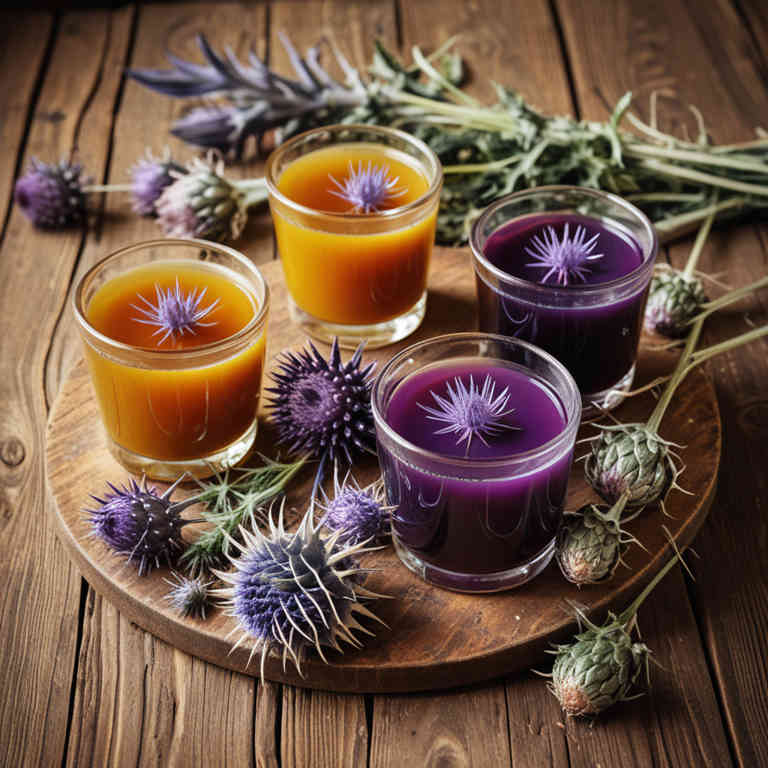
Silybum marianum herbal juices are used to support liver health and detoxification due to their high concentration of silymarin, a group of flavonoids with potent antioxidant and anti-inflammatory properties.
These juices help protect liver cells from damage caused by toxins, alcohol, and certain medications, making them beneficial for individuals with liver disorders such as hepatitis or cirrhosis. Additionally, silymarin has been shown to promote the regeneration of liver tissue, enhancing the organ's ability to repair itself. The anti-inflammatory effects of these juices may also contribute to reducing oxidative stress throughout the body, supporting overall wellness.
Because of these benefits, silybum marianum herbal juices are increasingly sought after as a natural supplement for liver support and general health maintenance.
5. Curcuma longa

Curcuma longa herbal juices are used to promote digestive health by stimulating the production of bile and aiding in the digestion of fats.
They are also valued for their anti-inflammatory properties, which can help reduce swelling and pain in conditions like arthritis. These juices are commonly used in traditional medicine to support liver function and detoxification processes in the body. Additionally, curcuma longa juices may contribute to skin health by reducing oxidative stress and improving skin complexion.
Their versatility and natural therapeutic properties make them a popular choice in both culinary and medicinal applications.
6. Rosa canina
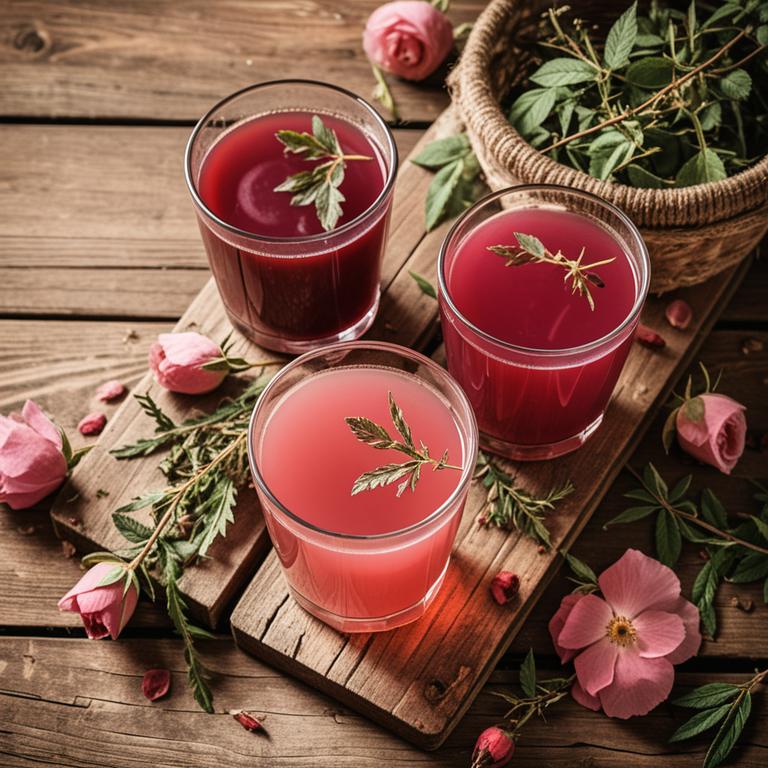
Rosa canina herbal juices are used to support immune function and promote overall wellness due to their high content of vitamin C and antioxidants.
These juices are also valued for their ability to aid in the treatment of respiratory conditions, such as colds and coughs, by reducing inflammation and boosting the body's defenses. Additionally, rosa canina is often incorporated into skincare routines because of its moisturizing and anti-inflammatory properties, which can help improve skin health and appearance. The juice is also used in traditional medicine to support digestive health and reduce symptoms of gastrointestinal issues.
Overall, the versatility and nutritional benefits of rosa canina herbal juices make them a valuable addition to both dietary and therapeutic regimens.
7. Salvia officinalis
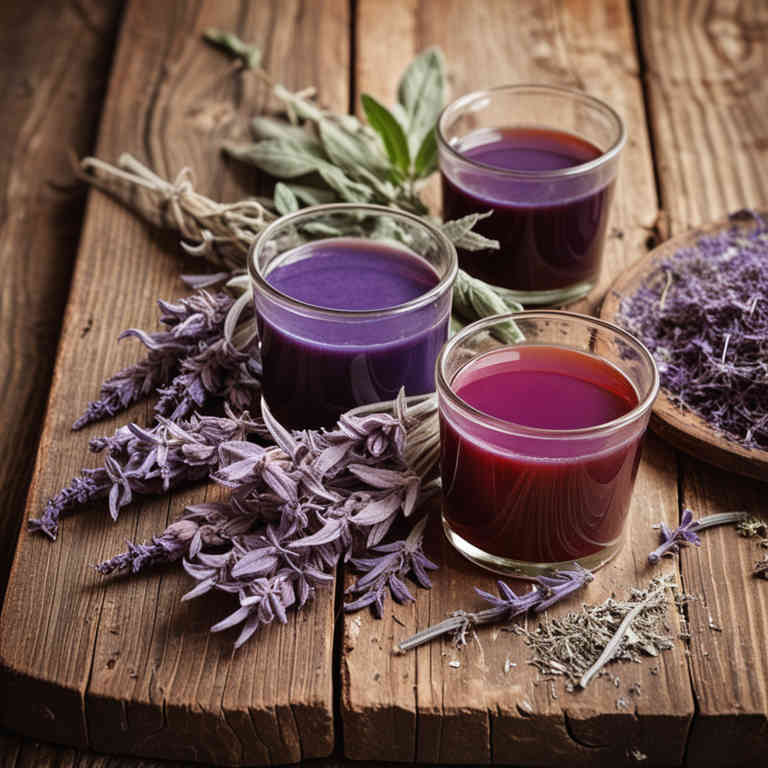
Salvia officinalis herbal juices are used to support digestive health by stimulating the secretion of digestive enzymes and improving gut motility.
They are also valued for their antioxidant properties, which help neutralize free radicals and reduce oxidative stress in the body. These juices are often incorporated into traditional remedies to alleviate symptoms of respiratory conditions such as coughs and sore throats due to their expectorant effects. Additionally, salvia officinalis juices are believed to promote mental clarity and reduce stress, making them a popular choice in herbal medicine for cognitive and emotional wellness.
Their versatility and potential therapeutic benefits make them a valuable component in both culinary and medicinal applications.
8. Glycyrrhiza glabra
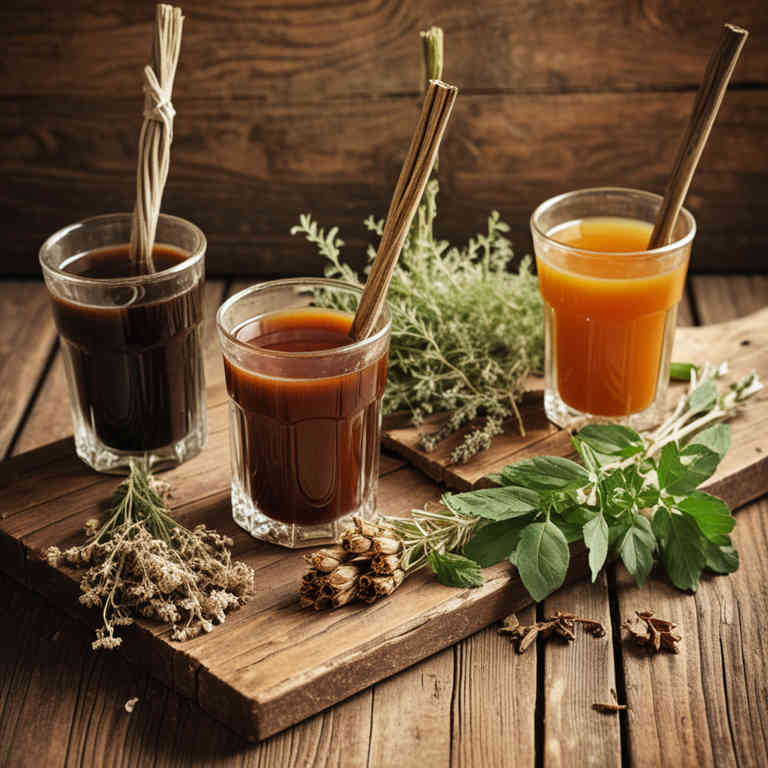
Glycyrrhiza glabra herbal juices are used to support respiratory health by soothing sore throats and reducing inflammation in the airways.
These juices contain compounds like glycyrrhizin, which have antiviral and anti-inflammatory properties that can help alleviate symptoms of colds, coughs, and bronchitis. They are also commonly used in traditional medicine to aid digestion by reducing stomach acidity and promoting the healing of ulcers. Additionally, glycyrrhiza glabra juices may help in managing stress by regulating cortisol levels, making them beneficial for mental well-being.
Due to their wide range of therapeutic effects, these juices are valued in both herbal remedies and modern health practices.
9. Cnicus benedictus

Cnicus benedictus herbal juices are used to support digestive health by stimulating the production of digestive enzymes and promoting the overall function of the gastrointestinal tract.
They are also valued for their potential to alleviate symptoms of indigestion, bloating, and flatulence due to their mild laxative properties. The juice is believed to help detoxify the body by supporting the liver and kidneys in eliminating toxins. Additionally, it may contribute to skin health by promoting a clearer complexion and reducing inflammation.
These benefits make Cnicus benedictus a popular choice in traditional herbal medicine for maintaining overall wellness.
10. Echinacea purpurea
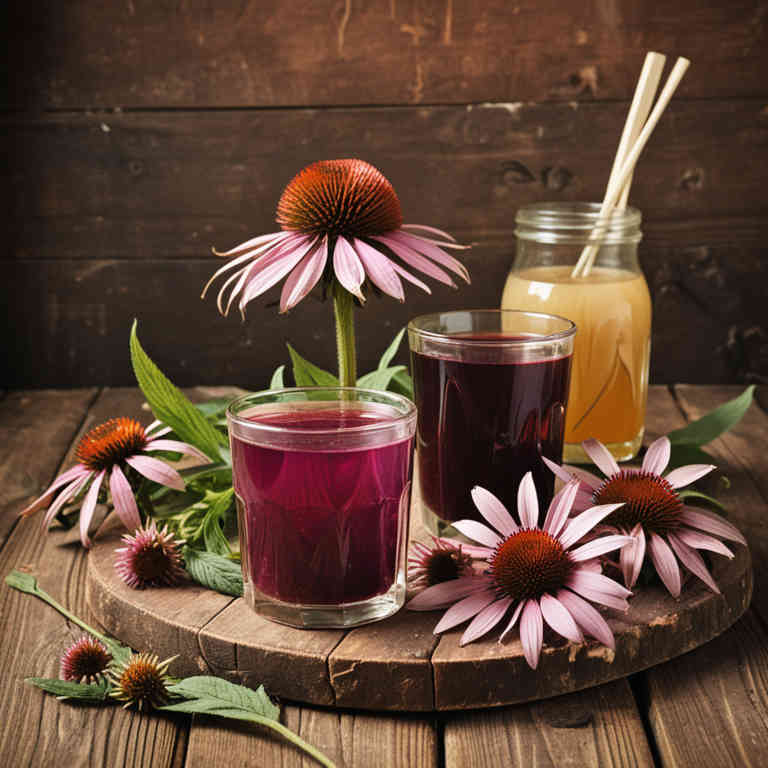
Echinacea purpurea herbal juices are used to boost the immune system and reduce the severity and duration of colds and respiratory infections.
These juices contain compounds like polysaccharides, flavonoids, and alkamides, which have anti-inflammatory and immunostimulant properties. They are often consumed during the cold and flu season to help the body fight off viral infections more effectively. Additionally, echinacea purpurea juices may support overall wellness by promoting the health of the skin, mucous membranes, and other body tissues.
Their popularity as a natural remedy is due to their relatively safe profile and potential to enhance the body's natural defenses without the side effects associated with synthetic medications.
11. Piper nigrum
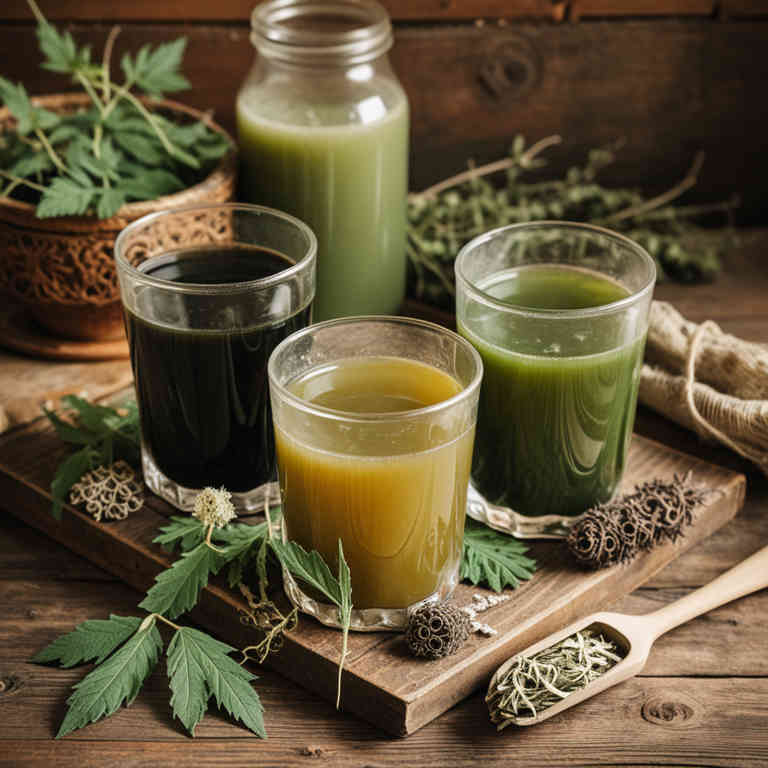
Piper nigrum herbal juices are used to support digestive health due to their rich content of essential oils and alkaloids that stimulate digestion and reduce bloating.
These juices are also valued for their antioxidant properties, which help protect cells from oxidative stress and boost the immune system. In traditional medicine, piper nigrum herbal juices are used to alleviate symptoms of respiratory conditions such as coughs and colds by acting as a natural decongestant. Additionally, they are incorporated into skincare routines for their antimicrobial and anti-inflammatory effects, helping to clear acne and soothe skin irritation.
Overall, the versatility of piper nigrum herbal juices makes them a valuable addition to both internal health and topical care regimens.
12. Mentha piperita
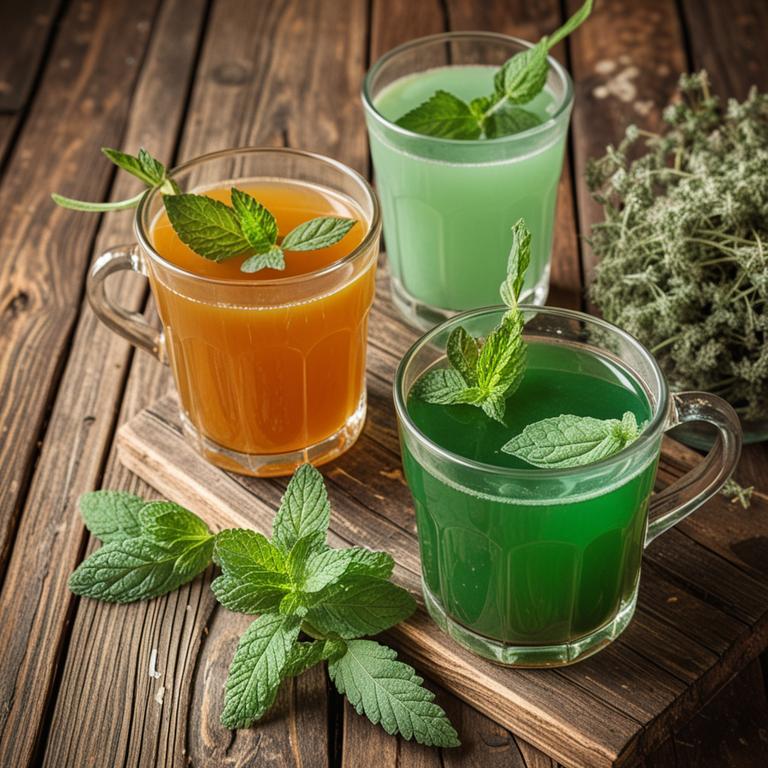
Mentha piperita herbal juices are used to support digestive health by stimulating the production of digestive enzymes and relieving symptoms of indigestion, bloating, and gas.
They are also commonly used to freshen breath and reduce oral bacteria due to their natural antimicrobial properties. These juices can help alleviate headaches and migraines by promoting relaxation and reducing stress through their calming effects. Additionally, mentha piperita juices are often used in aromatherapy to enhance mental clarity and improve mood.
Their versatility makes them a popular choice for both traditional and modern wellness practices.
13. Rosmarinus officinalis

Rosmarinus officinalis herbal juices are used to enhance cognitive function and memory retention due to their high concentration of antioxidants and anti-inflammatory compounds.
These juices are also beneficial for reducing stress and promoting mental clarity, making them popular in aromatherapy and holistic wellness practices. The essential oils found in the juice can stimulate blood circulation and support respiratory health when used in inhalation therapies. Additionally, rosmarinus officinalis juices are incorporated into skincare products to treat acne and improve skin texture due to their antibacterial properties.
Overall, the versatility of these herbal juices makes them a valuable component in both internal health and external care routines.
14. Aloe barbadensis
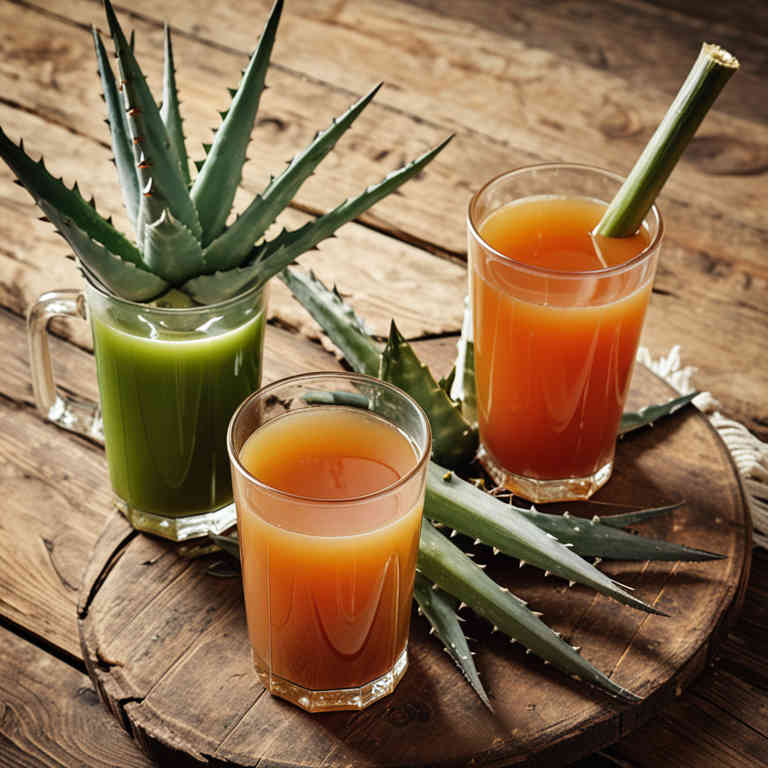
Aloe barbadensis herbal juices are used to promote skin health and healing due to their soothing and anti-inflammatory properties.
These juices contain vitamins, minerals, and amino acids that help in reducing skin irritation, redness, and scars. They are also commonly used to treat burns, sunburns, and other skin conditions because of their natural cooling effect. Additionally, aloe juice is beneficial for digestive health, as it can aid in relieving constipation and supporting gut health.
Overall, the versatility of aloe barbadensis herbal juices makes them a valuable natural remedy for both external and internal wellness.
15. Cuminum cyminum
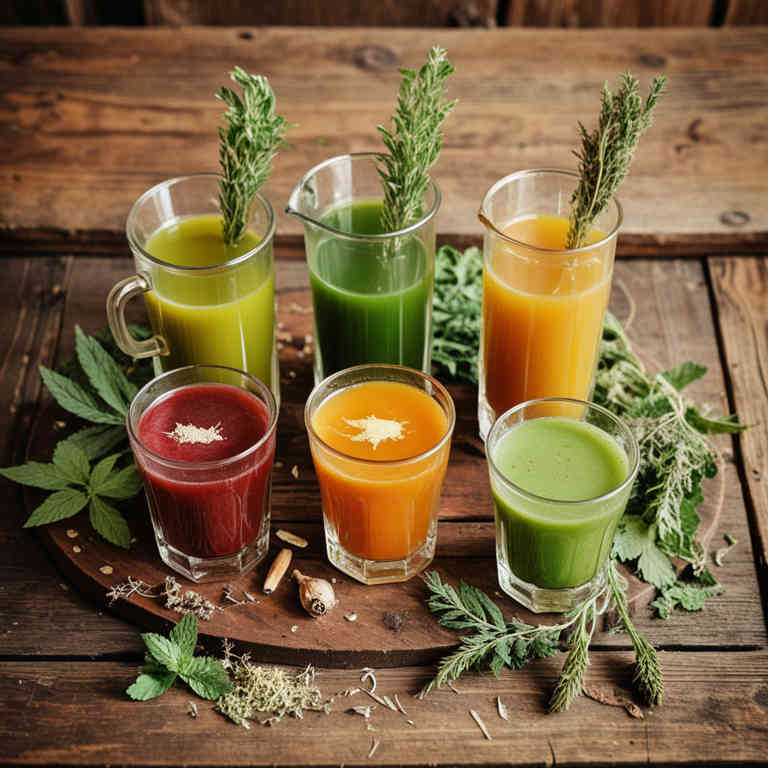
Cuminum cyminum herbal juices are used to promote digestive health by stimulating the production of digestive enzymes and reducing bloating.
They are also known to support respiratory function by acting as a natural decongestant and helping to alleviate symptoms of colds and asthma. These juices may aid in reducing inflammation due to their high antioxidant content, which can help protect cells from damage. Additionally, cuminum cyminum is believed to have antimicrobial properties that can support immune health.
Overall, the use of cuminum cyminum herbal juices is valued for their holistic benefits in enhancing both digestive and respiratory wellness.
16. Foeniculum vulgare
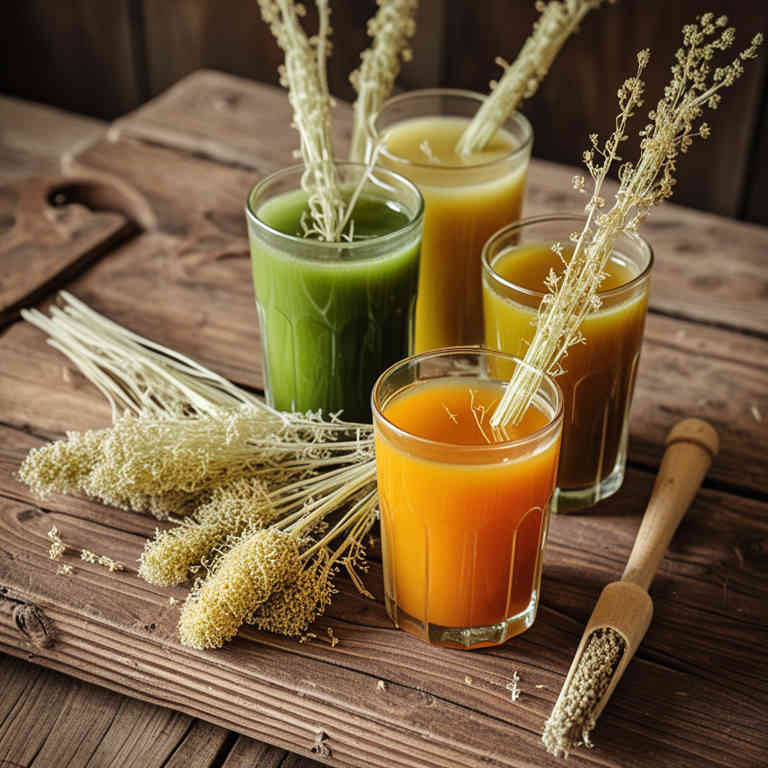
Foeniculum vulgare herbal juices are used to support digestive health by stimulating the production of digestive enzymes and reducing bloating.
These juices are also known to help alleviate symptoms of indigestion and gas due to their carminative properties. Additionally, foeniculum vulgare is valued for its ability to soothe the respiratory system, making it useful in treating coughs and bronchitis. The essential oils in the juice may also have antimicrobial properties that contribute to overall immune support.
Because of these benefits, foeniculum vulgare herbal juices are commonly incorporated into natural remedies and dietary supplements for promoting wellness.
17. Vitis vinifera
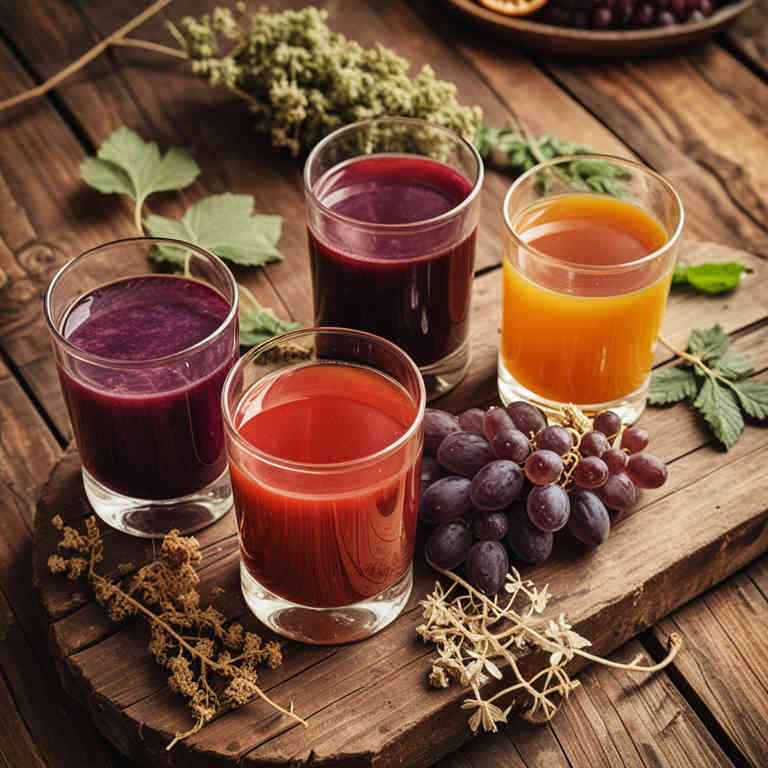
Vitis vinifera herbal juices are used to promote overall health and wellness through their rich nutritional profile.
These juices, derived from grapes, are known for their high content of antioxidants, particularly resveratrol, which helps combat oxidative stress and inflammation in the body. They are also valued for their potential to support heart health by improving blood circulation and reducing cholesterol levels. Additionally, the natural sugars in these juices can provide a quick energy boost, making them a popular choice for athletes and active individuals.
Overall, vitis vinifera herbal juices are appreciated for their ability to enhance vitality and contribute to long-term well-being.
18. Lavandula angustifolia
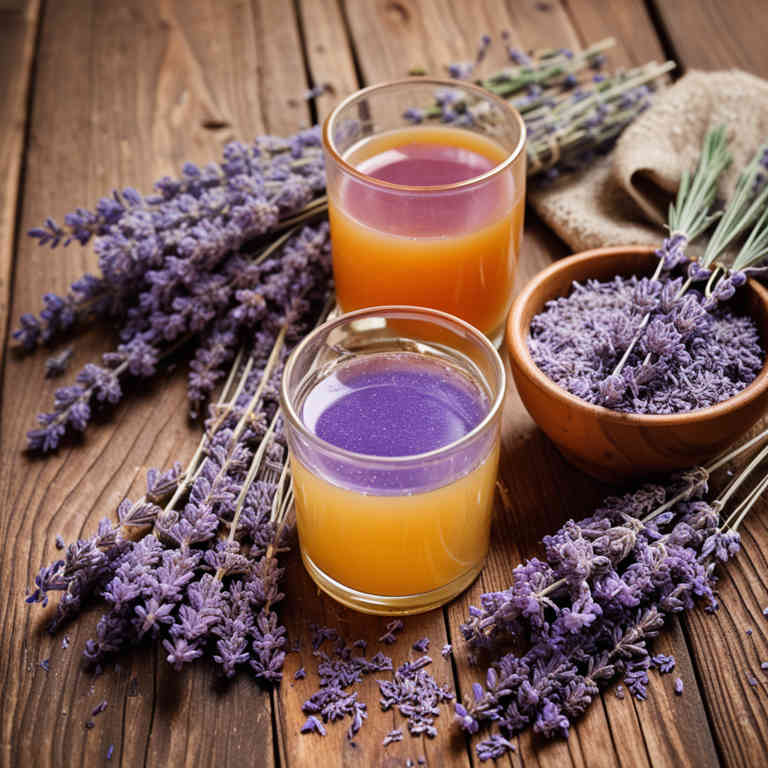
Lavandula angustifolia herbal juices are used to promote relaxation and reduce stress due to their calming properties.
These juices are also beneficial for skin health, as they can help soothe irritations and reduce inflammation. They are often used in aromatherapy to enhance mood and create a peaceful environment. The natural antioxidants in lavender juice may support immune function and overall well-being.
Additionally, lavender herbal juices are valued for their potential to aid in sleep and alleviate symptoms of anxiety.
19. Achillea millefolium
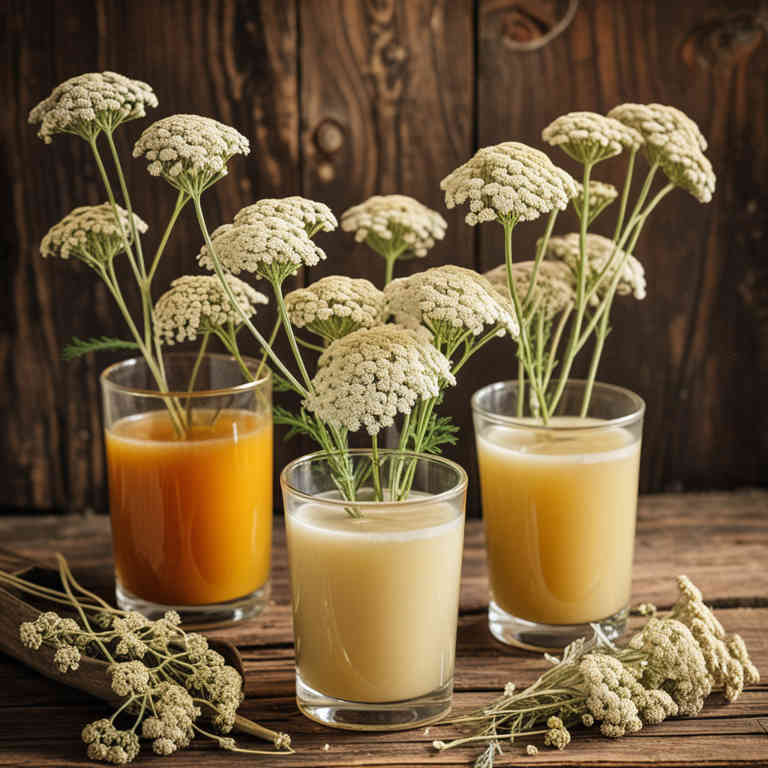
Achillea millefolium herbal juices are used to support digestive health due to their mild astringent properties that can help soothe upset stomachs and reduce inflammation in the gastrointestinal tract.
These juices are also valued for their potential to promote skin health, as they contain compounds that may help with wound healing and reduce the appearance of scars. Additionally, achillea millefolium is often used in traditional medicine to alleviate symptoms of anxiety and stress, thanks to its calming effects on the nervous system. The plant's high content of flavonoids and antioxidants contributes to its ability to combat oxidative stress and support overall immune function.
Because of these diverse benefits, achillea millefolium herbal juices are increasingly popular in natural health remedies and holistic wellness practices.
20. Hypericum perforatum
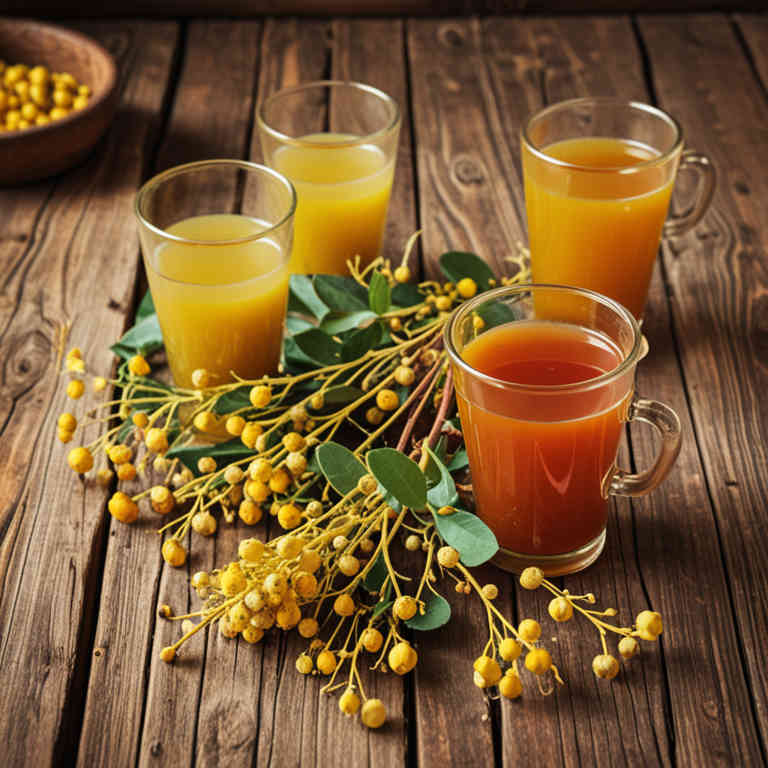
Hypericum perforatum herbal juices are used to support mental health and alleviate symptoms of mild depression and anxiety.
They contain active compounds like hypericin and flavonoids, which are believed to have antidepressant and anti-inflammatory properties. These juices are also utilized in traditional medicine to promote wound healing and reduce inflammation due to their antiseptic qualities. Additionally, they may aid in improving sleep quality and reducing stress levels, making them a popular choice in holistic health practices.
The versatility of hypericum perforatum herbal juices makes them a valuable natural remedy for a range of emotional and physical wellness needs.
21. Cinnamomum verum
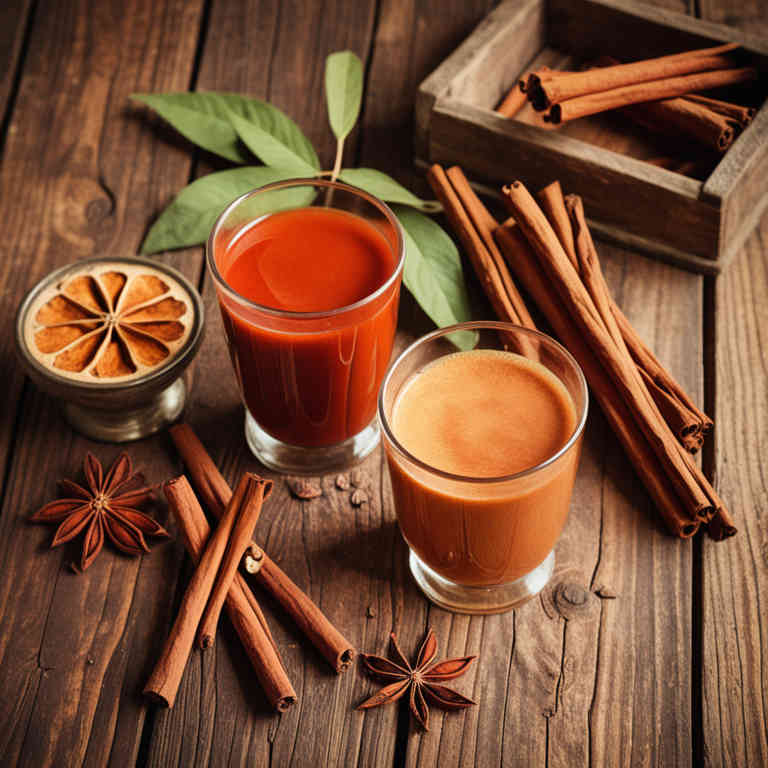
Cinnamomum verum herbal juices are used to support digestive health due to their natural anti-inflammatory and antimicrobial properties.
These juices can help alleviate symptoms of indigestion, bloating, and nausea by promoting healthy gut function. They are also known to aid in regulating blood sugar levels, making them beneficial for individuals with diabetes or insulin resistance. Additionally, the aromatic compounds in the juice can have a calming effect, helping to reduce stress and improve mental clarity.
Overall, cinnamomum verum herbal juices offer a range of health benefits that make them a valuable addition to a holistic wellness routine.
22. Nigella sativa

Nigella sativa herbal juices are used to support immune system function due to their high concentration of thymoquinone, a compound known for its anti-inflammatory and antioxidant properties.
These juices are also commonly consumed to aid in digestion by stimulating the production of digestive enzymes and reducing gastrointestinal discomfort. Additionally, they are valued for their potential to alleviate respiratory issues, such as asthma and coughs, by acting as a natural bronchodilator. The antioxidant properties of nigella sativa juices may also contribute to skin health by promoting healing and reducing inflammation.
Overall, the use of these juices is rooted in their ability to provide holistic health benefits across multiple bodily systems.
23. Equisetum arvense
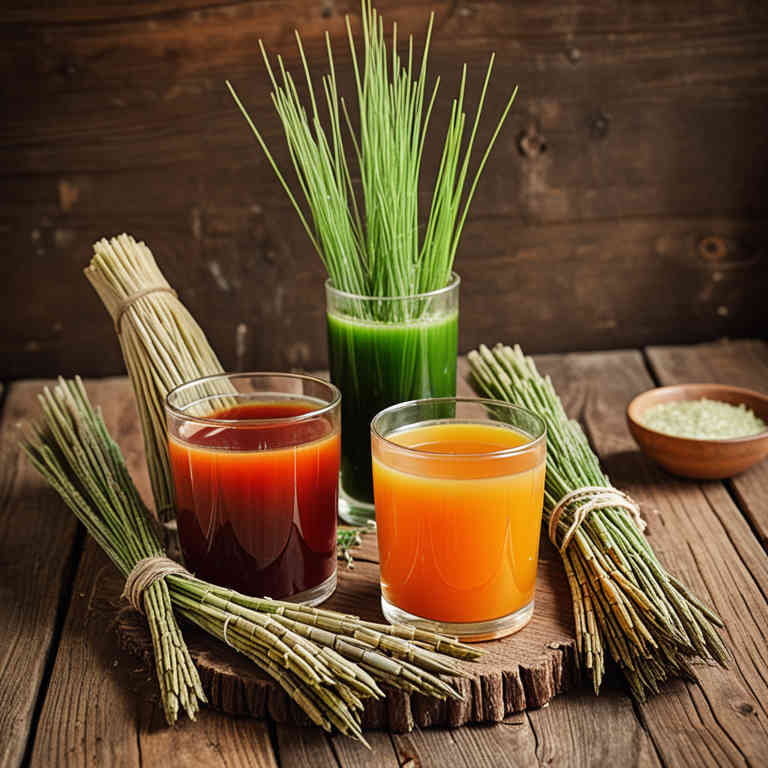
Equisetum arvense herbal juices are used to support detoxification processes in the body due to their high concentration of silica and other bioactive compounds.
These juices are believed to aid in the removal of heavy metals and toxins from the bloodstream, making them popular in alternative medicine for cleansing purposes. They are also used to promote healthy skin and hair by strengthening connective tissues and improving cellular function. In traditional herbal practices, equisetum arvense juices are valued for their potential anti-inflammatory and antioxidant properties.
However, it is important to consult a healthcare professional before using these juices, as they may interact with certain medications or have adverse effects in some individuals.
24. Nymphaea alba
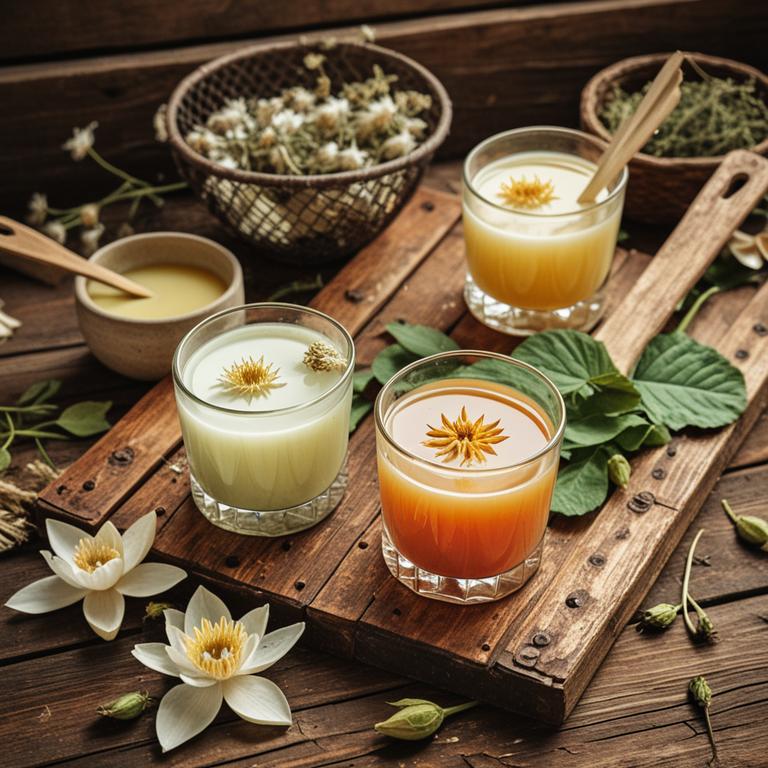
Nymphaea alba herbal juices are used to promote skin health and treat various skin conditions due to their high content of antioxidants and anti-inflammatory compounds.
These juices help in reducing acne, redness, and other inflammatory skin issues by soothing the skin and preventing bacterial growth. Additionally, they are valued for their ability to rejuvenate the skin, improve its texture, and enhance its natural glow. The presence of essential nutrients like vitamins and minerals further supports overall skin vitality and repair processes.
Because of these benefits, nymphaea alba herbal juices are increasingly popular in natural skincare products and traditional remedies.
25. Cinnamomum zeylanicum

Cinnamomum zeylanicum herbal juices are used to promote digestive health due to their natural antispasmodic and carminative properties.
These juices help alleviate symptoms of indigestion, bloating, and gas by stimulating the digestive system and reducing inflammation in the gastrointestinal tract. They are also beneficial for managing blood sugar levels, as cinnamon has been shown to enhance insulin sensitivity and regulate glucose metabolism. Additionally, the antioxidant compounds in these juices support immune function and may reduce the risk of chronic diseases.
Overall, cinnamomum zeylanicum herbal juices are valued for their multifaceted health benefits, making them a popular natural remedy in traditional and modern wellness practices.
26. Thymus vulgaris
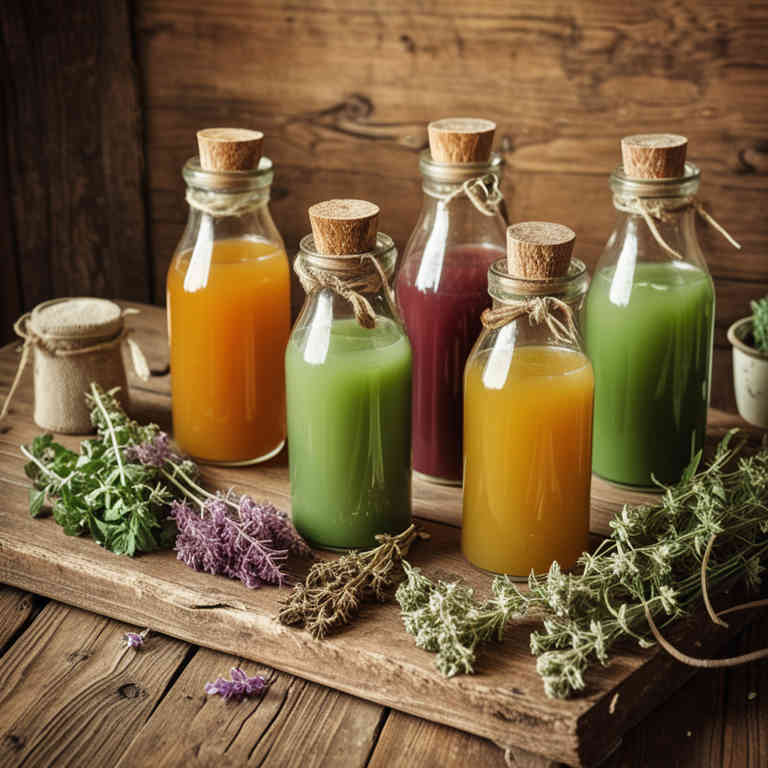
Thymus vulgaris herbal juices are used to support respiratory health by alleviating symptoms of coughs, colds, and bronchitis due to their antimicrobial and anti-inflammatory properties.
These juices are also valued for their ability to boost the immune system, making them beneficial during seasonal changes or periods of increased vulnerability. Additionally, thymus vulgaris juices are often incorporated into natural remedies for stress relief and to enhance mental clarity, thanks to their stimulating and calming effects on the nervous system. Their high concentration of antioxidants helps protect cells from damage, contributing to overall wellness and longevity.
Overall, the versatility and therapeutic benefits of thymus vulgaris herbal juices make them a popular choice in both traditional and modern herbal medicine.
27. Matricaria chamomilla
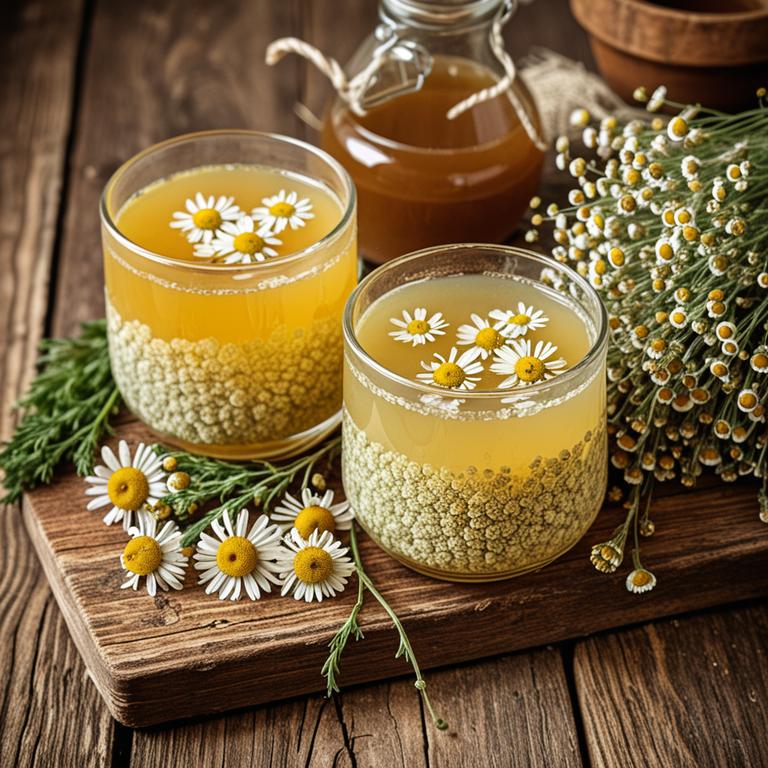
Matricaria chamomilla herbal juices are used to promote relaxation and ease digestive discomfort due to their calming and anti-inflammatory properties.
These juices are often consumed to alleviate symptoms of anxiety, insomnia, and stress-related conditions by interacting with the body's nervous system. They are also beneficial for soothing gastrointestinal issues such as indigestion, bloating, and inflammatory bowel conditions. The active compounds in chamomilla, like apigenin and bisabolol, contribute to its therapeutic effects by reducing inflammation and muscle spasms.
Because of these benefits, matricaria chamomilla herbal juices are widely used in herbal medicine and natural health practices for overall well-being.
28. Ginkgo biloba
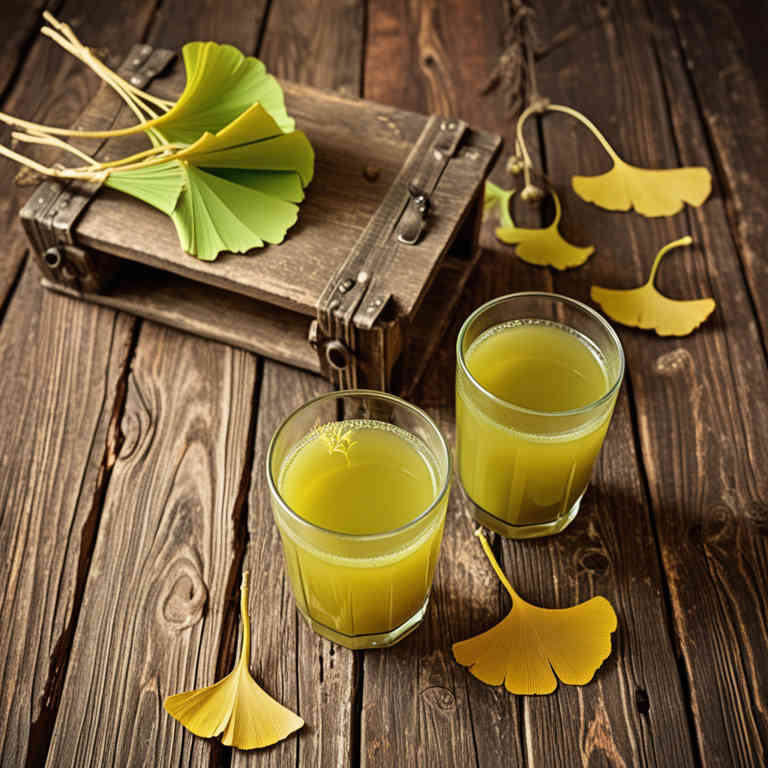
Ginkgo biloba herbal juices are used to enhance cognitive function and improve memory by increasing blood flow to the brain.
They are also popular for their potential to support circulatory health, as they contain compounds that may help dilate blood vessels and reduce inflammation. These juices are often consumed to alleviate symptoms of anxiety and stress due to their calming effects on the nervous system. Additionally, ginkgo biloba is believed to have antioxidant properties that protect cells from damage, contributing to overall well-being.
Because of these benefits, it is commonly used in herbal remedies for both mental and physical health support.
29. Camellia sinensis
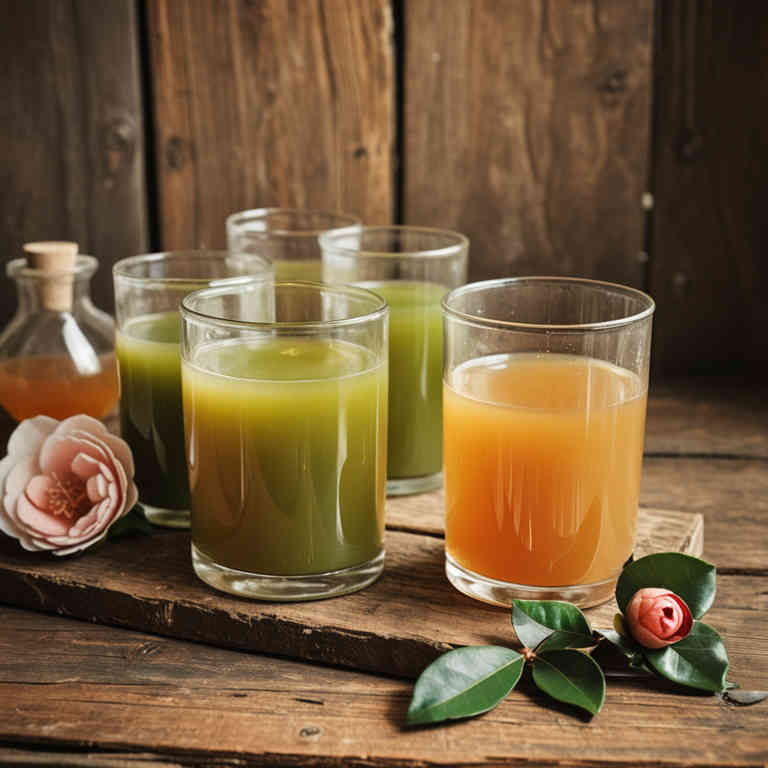
Camellia sinensis herbal juices are used to promote overall health and well-being through their rich content of antioxidants, vitamins, and minerals.
These juices are known to support cardiovascular health by helping to lower cholesterol levels and improve blood flow. They also aid in enhancing mental clarity and focus due to their caffeine and L-theanine content, which can stimulate the central nervous system. Additionally, camellia sinensis juices are beneficial for digestion and can help in reducing inflammation in the body.
Their versatility makes them a popular choice for both daily consumption and as a natural remedy for various ailments.
30. Chamomilla recutita
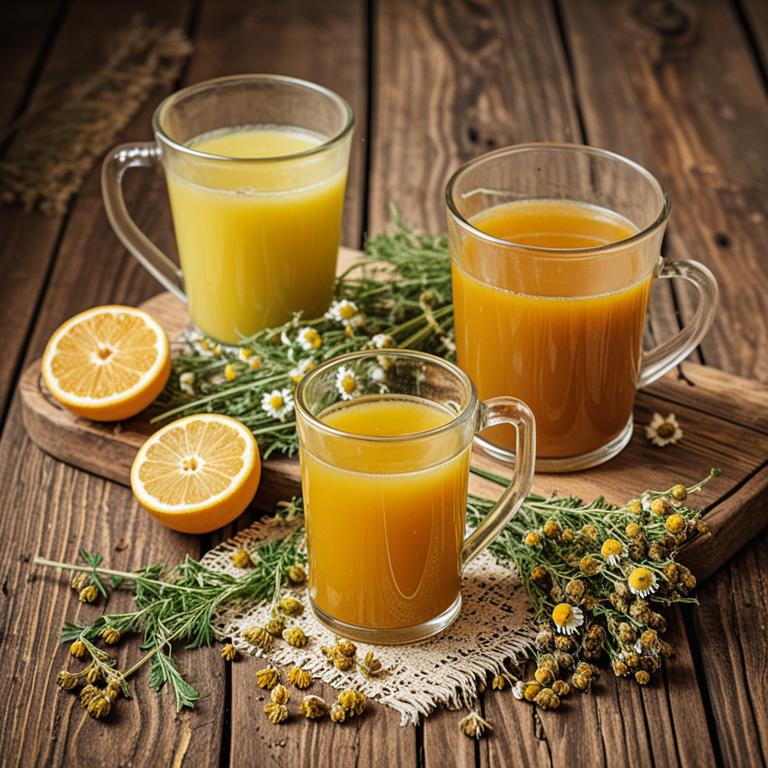
Chamomilla recutita herbal juices are used to promote relaxation and alleviate symptoms of anxiety and stress.
These juices contain compounds like apigenin, which have mild sedative effects and can help calm the nervous system. They are also commonly used to soothe digestive issues such as indigestion and bloating due to their anti-inflammatory and antispasmodic properties. Additionally, chamomilla recutita juices may support skin health by reducing inflammation and promoting healing in minor skin irritations.
Overall, their calming and healing properties make them a popular choice for natural remedies in both traditional and modern wellness practices.
31. Pimpinella anisum
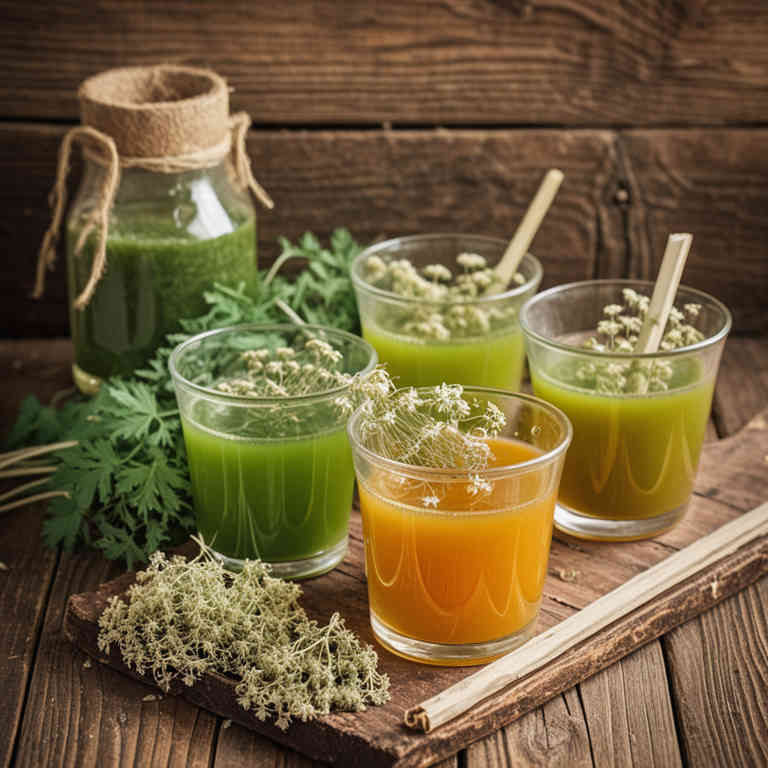
Pimpinella anisum herbal juices are used to support digestive health due to their carminative properties, which help relieve gas and bloating.
These juices are also valued for their ability to soothe respiratory conditions, such as coughs and bronchitis, by acting as a natural expectorant. The essential oils in the juice can aid in reducing inflammation and promoting clear breathing, making it beneficial for those with asthma or other respiratory issues. Additionally, the juice is often consumed to alleviate nausea and motion sickness, thanks to its calming effects on the stomach.
Overall, the versatile nature of pimpinella anisum herbal juices makes them a popular choice in traditional and modern herbal medicine for their wide range of health benefits.
32. Petroselinum crispum
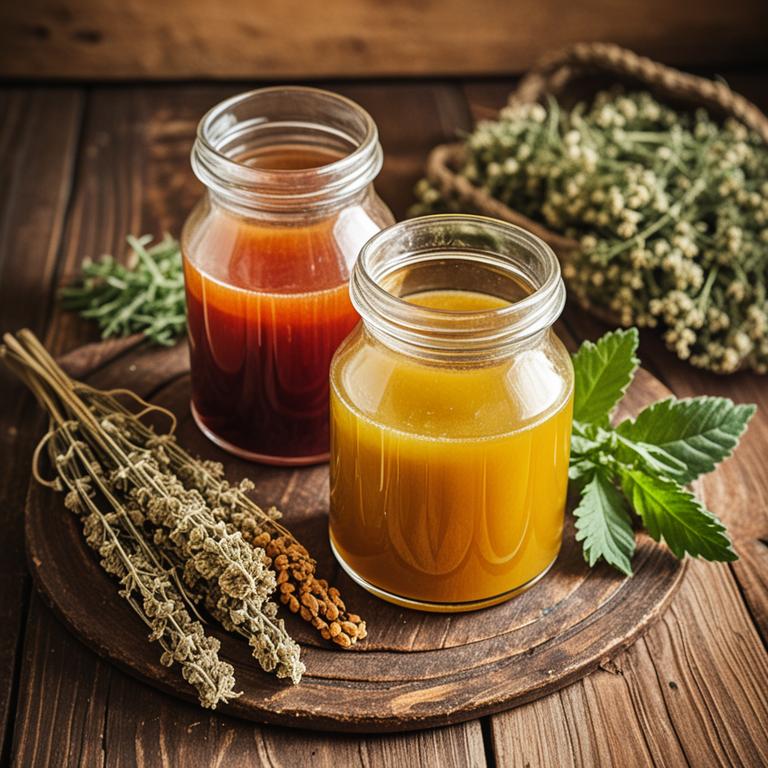
Petroselinum crispum herbal juices are used to support digestive health by stimulating the production of digestive enzymes and reducing bloating.
These juices are also known to help detoxify the body by promoting the elimination of toxins through the liver and kidneys. Additionally, they are valued for their ability to alleviate respiratory issues such as coughs and congestion due to their expectorant properties. The presence of antioxidants in petroselinum crispum juices helps combat oxidative stress and supports overall immune function.
Because of these benefits, petroselinum crispum herbal juices are often recommended as a natural remedy for improving overall wellness and vitality.
33. Prunus domestica
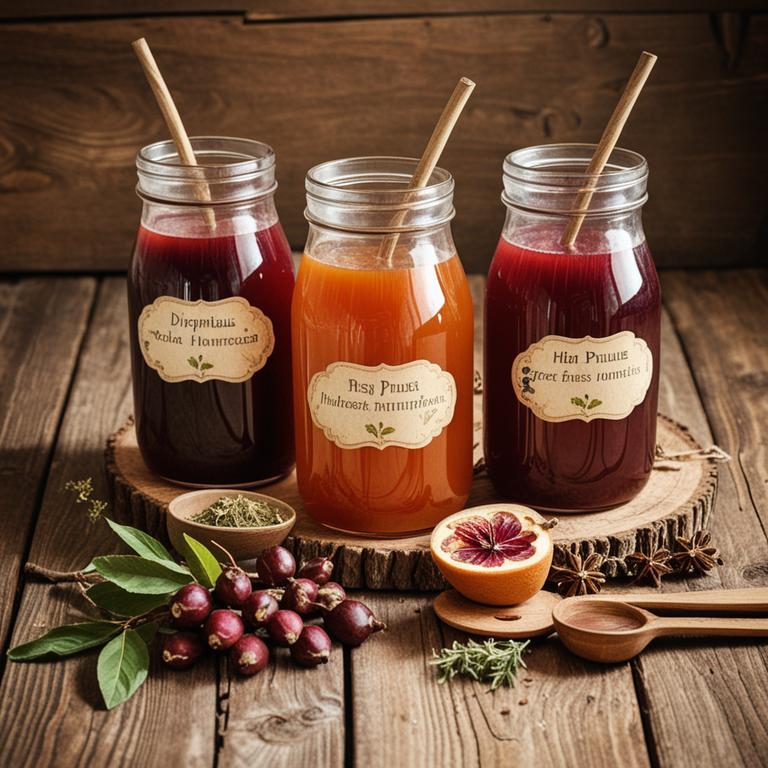
Prunus domestica herbal juices are used to support digestive health due to their high content of dietary fiber and enzymes that aid in breaking down food and promoting regular bowel movements.
These juices are also valued for their antioxidant properties, which help neutralize harmful free radicals in the body and reduce oxidative stress. Additionally, they are often consumed to boost the immune system, as they contain vitamins and minerals that strengthen the body's defenses against infections. The anti-inflammatory effects of prunus domestica juices can also help alleviate symptoms of conditions like irritable bowel syndrome and inflammatory bowel disease.
Overall, their natural composition makes them a beneficial addition to a healthy diet for overall wellness and disease prevention.
34. Artemisia absinthium
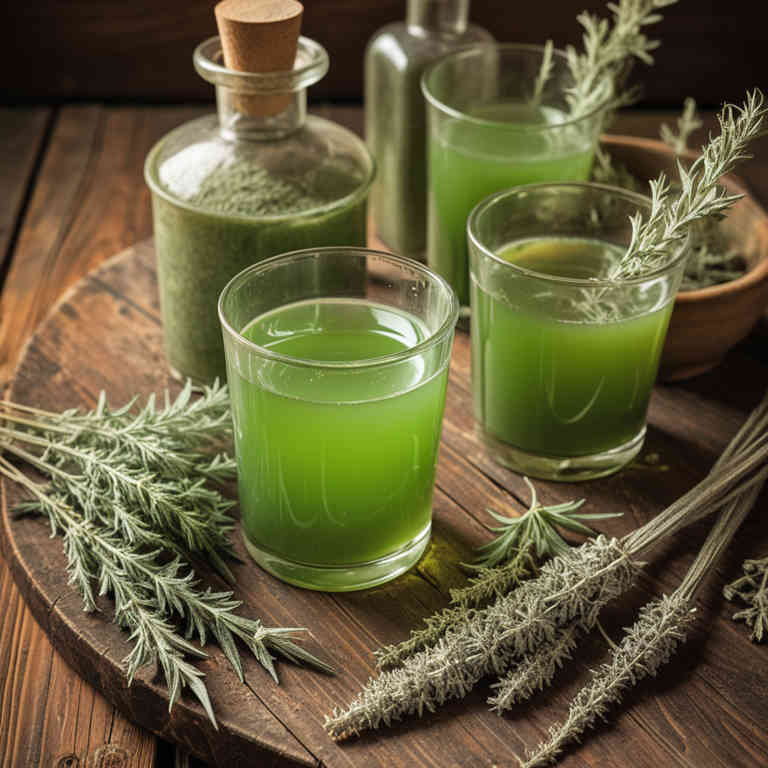
Artemisia absinthium herbal juices are used to support digestive health by stimulating the production of digestive enzymes and bile.
They are also known to aid in the treatment of liver disorders due to their detoxifying properties. These juices can help alleviate symptoms of indigestion, bloating, and nausea. Additionally, they have been traditionally used to reduce fever and treat malaria.
The presence of compounds like thujone and other essential oils contributes to their medicinal effects, making them a valuable component in herbal medicine.
35. Cymbopogon citratus
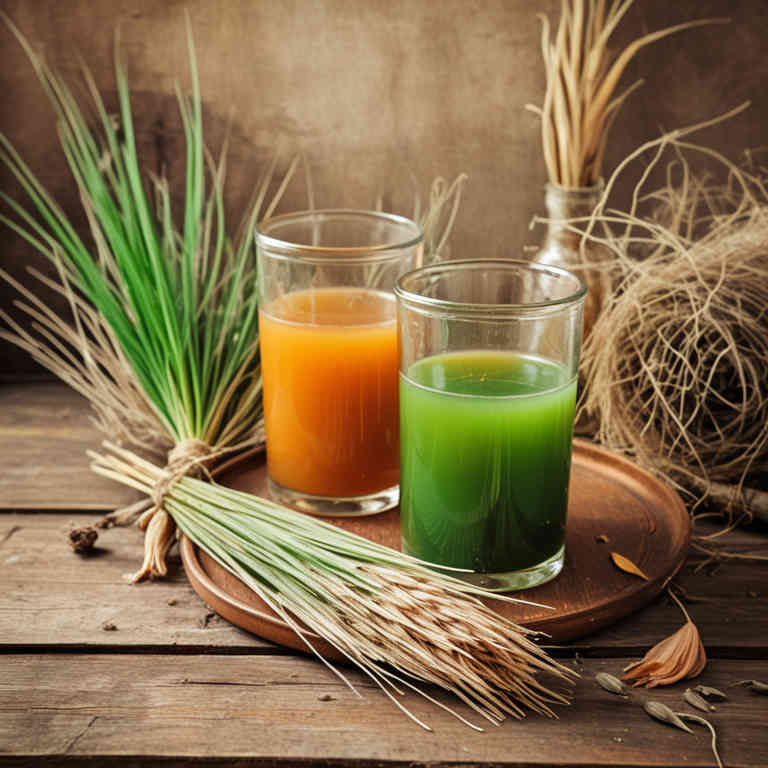
Cymbopogon citratus herbal juices are used to promote digestive health due to their high concentration of essential oils and bioactive compounds.
These juices are known to aid in reducing inflammation and soothing gastrointestinal discomfort, making them beneficial for individuals suffering from indigestion or irritable bowel syndrome. Additionally, the natural antioxidants present in cymbopogon citratus juices help protect the body from oxidative stress and support immune function. They are also commonly used in aromatherapy to relieve stress and enhance mental clarity, thanks to their calming and uplifting properties.
Overall, the versatility of cymbopogon citratus herbal juices makes them a valuable addition to both traditional and modern wellness practices.
36. Sambucus nigra
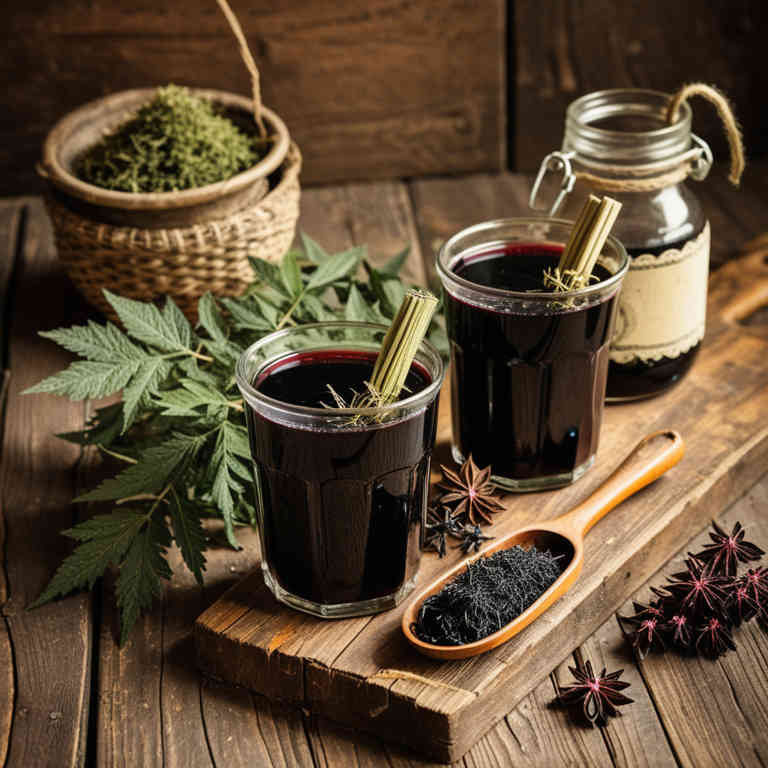
Sambucus nigra herbal juices are used to support immune function by stimulating the production of white blood cells and enhancing the body's defense mechanisms.
They are also valued for their antiviral and antiseptic properties, which can help in the treatment of colds, flu, and other respiratory infections. These juices are often consumed during the winter months to help prevent and alleviate symptoms of seasonal illnesses. Additionally, sambucus nigra is believed to have anti-inflammatory effects, making it useful in reducing fever and easing symptoms of inflammation.
Due to their rich content of antioxidants and bioactive compounds, these juices are increasingly popular in natural health remedies for overall wellness.
37. Allium sativum
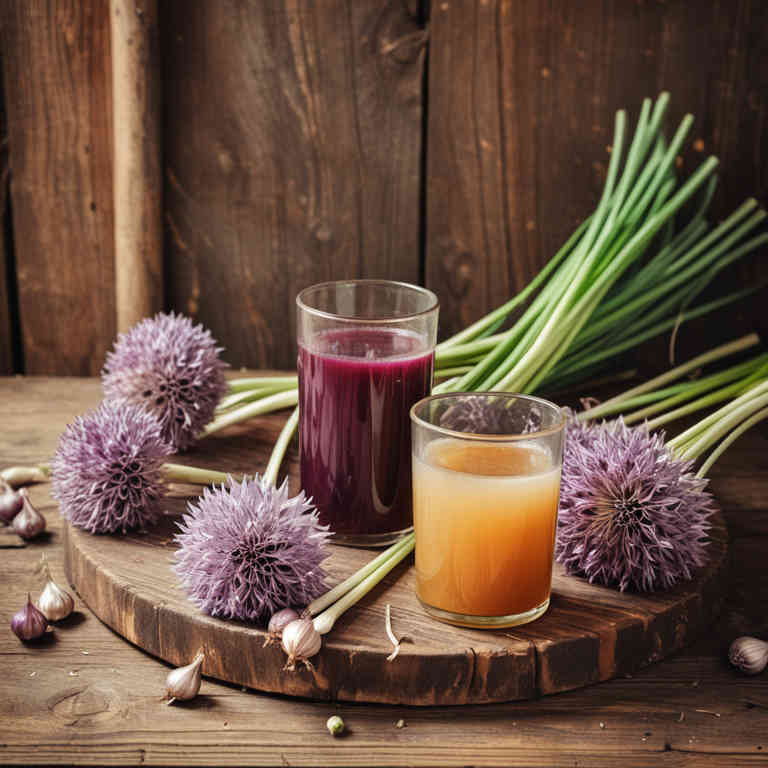
Allium sativum herbal juices are used to support cardiovascular health by helping to lower blood pressure and cholesterol levels.
These juices are also known for their anti-inflammatory properties, which can aid in reducing inflammation in the body and supporting immune function. They are often consumed to improve digestion and alleviate symptoms of indigestion or bloating. Additionally, the compounds in allium sativum juices, such as allicin, have been studied for their potential anti-cancer effects.
Overall, these juices are valued for their wide range of health benefits and natural healing properties.
38. Sabadilla tinctura

Sabadilla tinctura herbal juices are used to support respiratory health by alleviating symptoms of coughs, bronchitis, and other respiratory infections.
The active compounds in sabadilla, such as alkaloids, help to loosen mucus and reduce inflammation in the airways, making it easier to breathe. This herbal remedy is also valued for its potential antispasmodic properties, which may help relieve muscle spasms and digestive discomfort. Its traditional use extends to treating skin conditions and as a natural remedy for headaches and nervousness.
Due to its multiple therapeutic benefits, sabadilla tinctura is a popular choice in herbal medicine for promoting overall wellness.
39. Sanguinaria canadensis
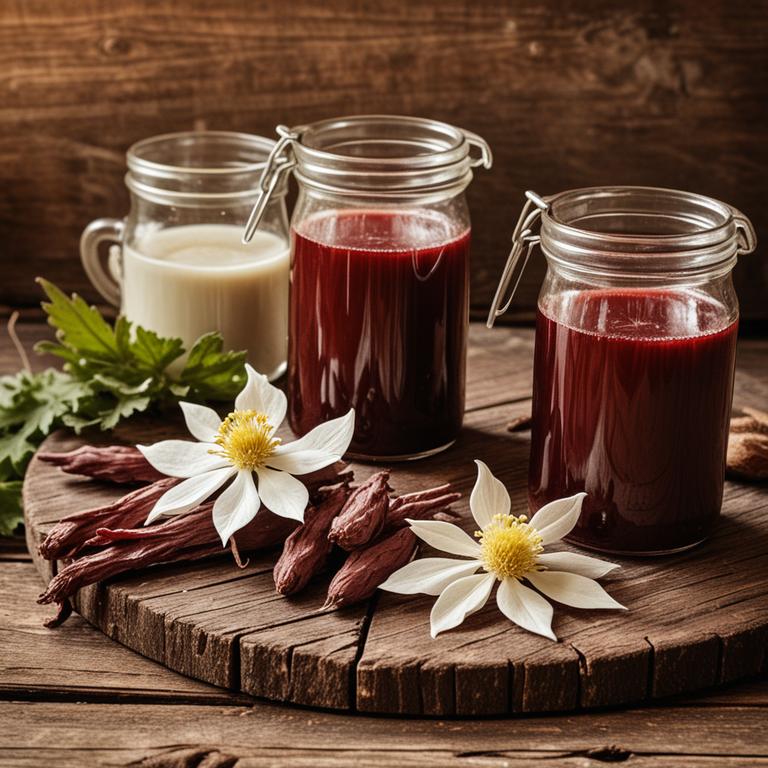
Sanguinaria canadensis herbal juices are used to treat various ailments, particularly those related to the respiratory and digestive systems.
The juice, derived from the roots of the plant, contains compounds that have antimicrobial and anti-inflammatory properties, which contribute to its medicinal value. Historically, it has been utilized in traditional medicine to alleviate symptoms of coughs, sore throats, and gastrointestinal discomfort. Its ability to stimulate the circulatory system also makes it beneficial for improving blood flow and reducing inflammation.
However, due to its potent nature, it should be used with caution and under professional guidance to avoid potential toxicity.
40. Centella asiatica
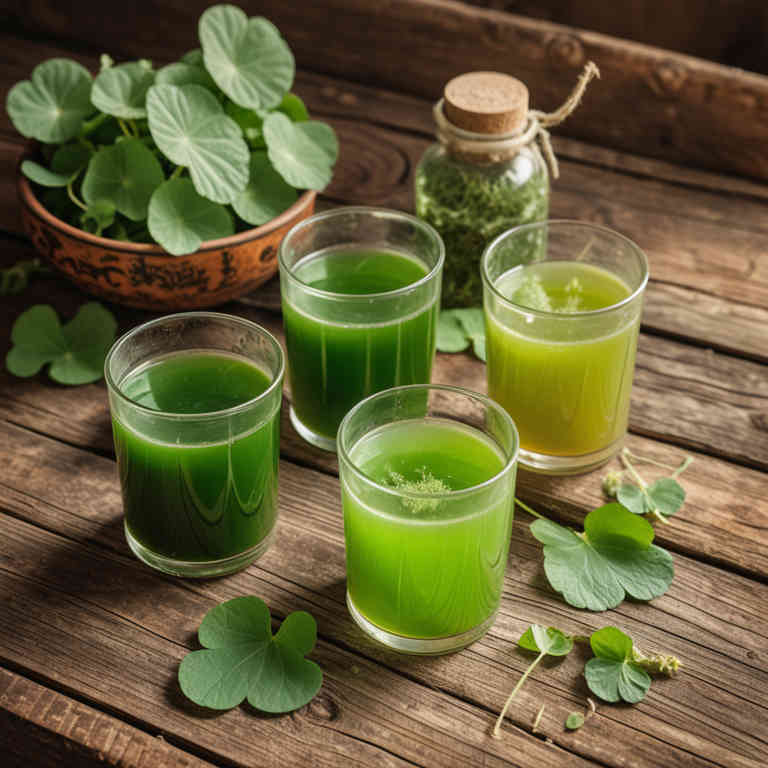
Centella asiatica herbal juices are used to promote skin health and wound healing due to their rich content of active compounds like asiatic acid and madecassol.
These compounds help stimulate collagen production, which strengthens the skin's structure and enhances its elasticity. They are also known to reduce inflammation and accelerate the recovery process in damaged skin, making them beneficial for treating burns, scars, and other skin conditions. Additionally, centella asiatica juices are used to support overall wellness by improving circulation and reducing stress-related symptoms.
Their natural properties make them a popular choice in both traditional and modern herbal medicine for their holistic healing benefits.
41. Eucalyptus globulus
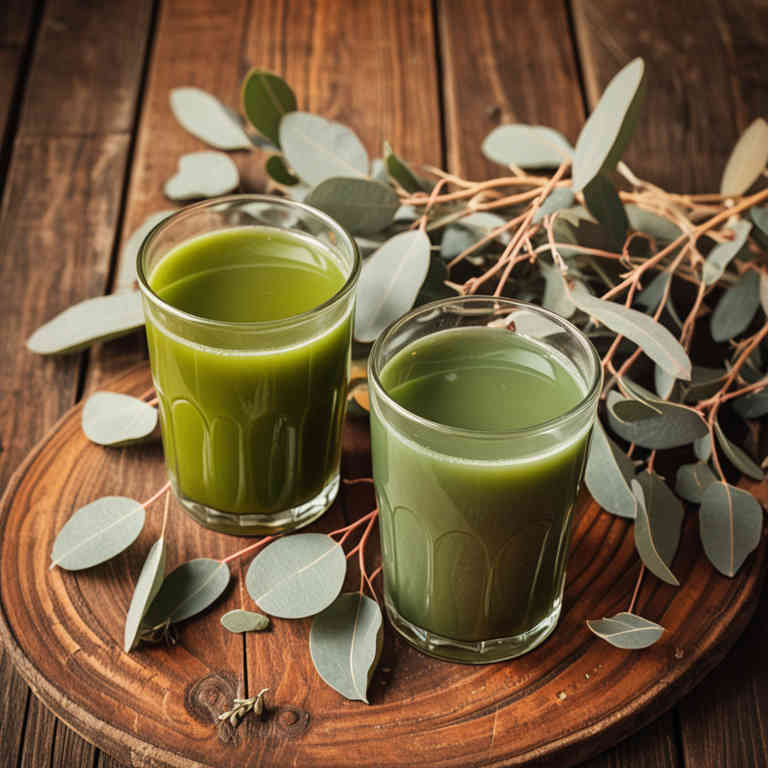
Eucalyptus globulus herbal juices are used to alleviate respiratory issues such as congestion, coughs, and bronchitis due to their high concentration of eucalyptol, which has antimicrobial and anti-inflammatory properties.
These juices can also help in reducing fever and providing relief from headaches by promoting sweating and clearing the sinuses. Additionally, they are beneficial for skin health as they can soothe irritations and reduce inflammation when applied topically. The natural antioxidants in eucalyptus globulus juices support immune function and may aid in detoxification processes within the body.
Overall, their versatility and natural therapeutic properties make them a valuable addition to both traditional and modern holistic health practices.
42. Nelumbo nucifera
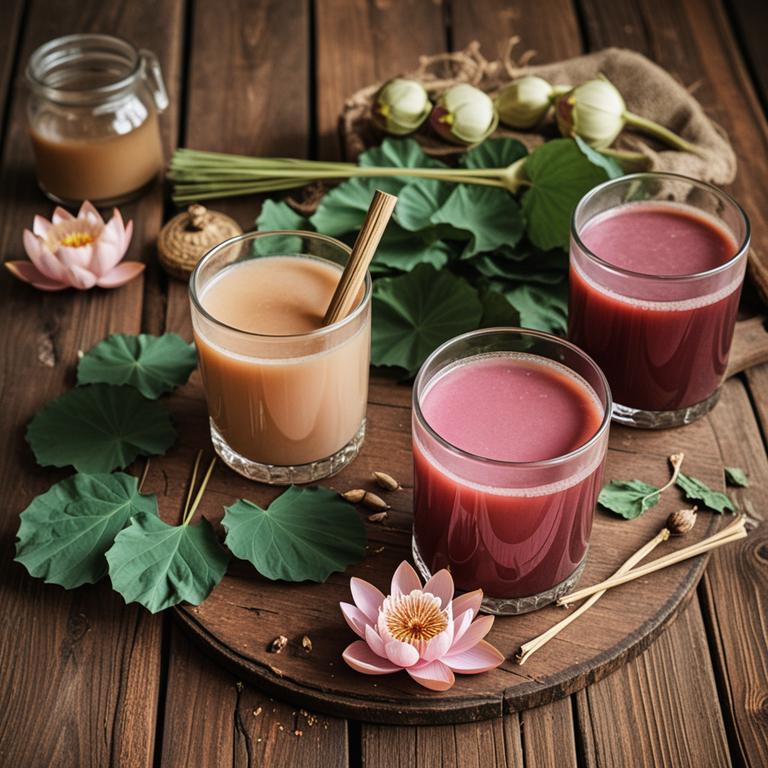
Nelumbo nucifera herbal juices are used to promote digestive health due to their rich content of enzymes and antioxidants that aid in the breakdown of food and the elimination of toxins from the body.
These juices are also valued for their ability to reduce inflammation, making them beneficial for individuals suffering from conditions such as arthritis or gastrointestinal disorders. The presence of vitamins and minerals like vitamin C, potassium, and magnesium further enhances their role in boosting immunity and maintaining overall bodily functions. In traditional Ayurvedic medicine, these juices are often recommended for their calming effects on the mind and body, helping to alleviate stress and improve mental clarity.
Overall, nelumbo nucifera herbal juices are a versatile and beneficial natural remedy that supports both physical and mental well-being.
43. Melissa officinalis
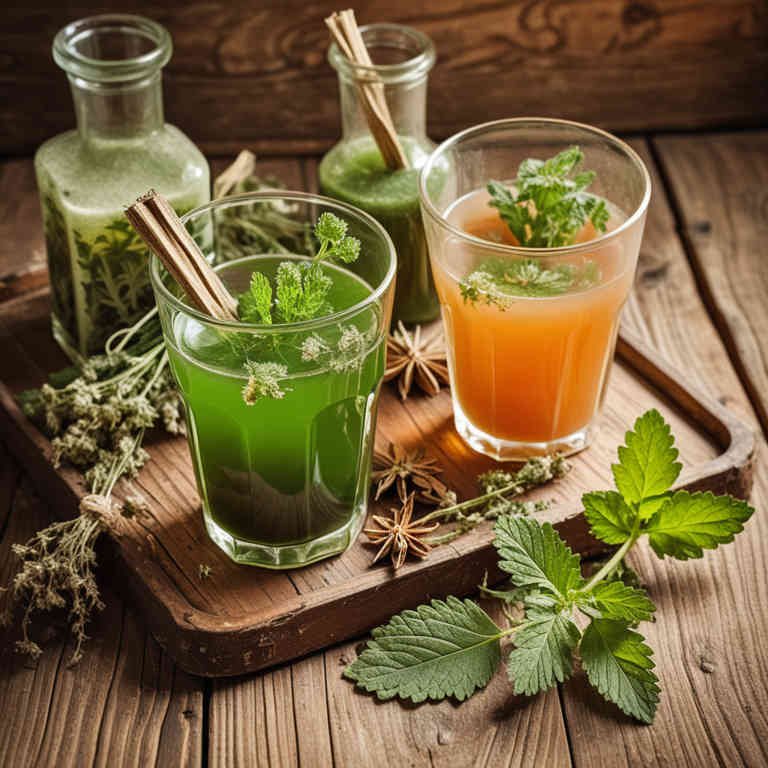
Melissa officinalis herbal juices are used to promote relaxation and reduce stress due to their calming properties.
These juices are rich in antioxidants and vitamins, which support overall health and immune function. They are also known to aid in digestion and can help alleviate symptoms of indigestion and bloating. The essential oils in melissa officinalis contribute to its ability to ease anxiety and improve mood.
Because of these benefits, melissa officinalis herbal juices are a popular choice for those seeking natural remedies for mental and physical well-being.
44. Pelargonium graveolens
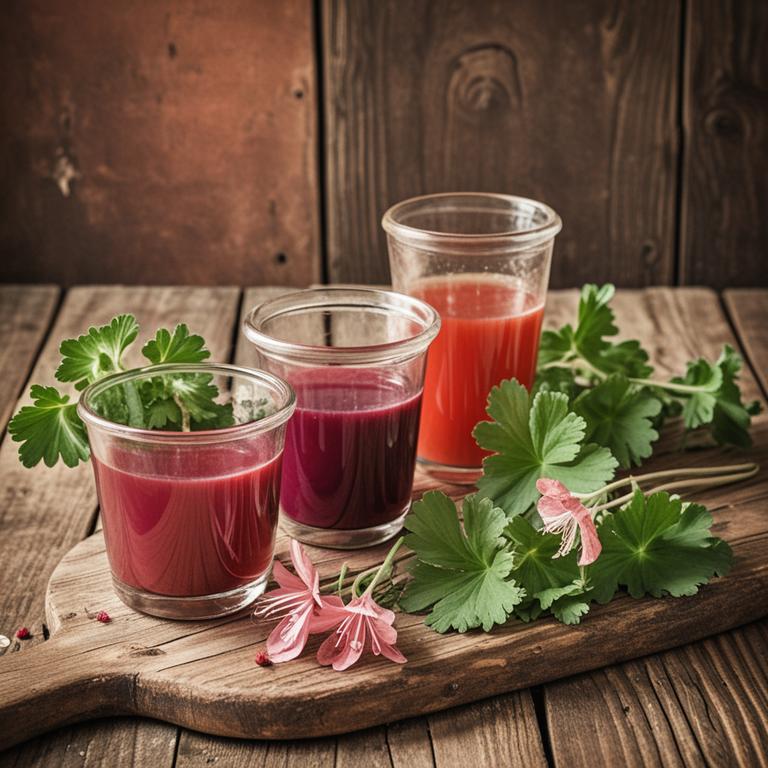
Pelargonium graveolens herbal juices are used to support respiratory health due to their anti-inflammatory and expectorant properties, which help alleviate symptoms of coughs and bronchitis.
These juices are also valued for their ability to reduce stress and anxiety, thanks to the presence of compounds like limonene and linalool that have calming effects on the nervous system. Additionally, they are employed in skincare for their antibacterial and astringent qualities, making them effective in treating acne and promoting skin clarity. The essential oils derived from these juices are commonly used in aromatherapy to enhance mood and promote relaxation.
Overall, the versatility of pelargonium graveolens herbal juices makes them a valuable natural remedy across various health and wellness applications.
45. Lepidium meyenii
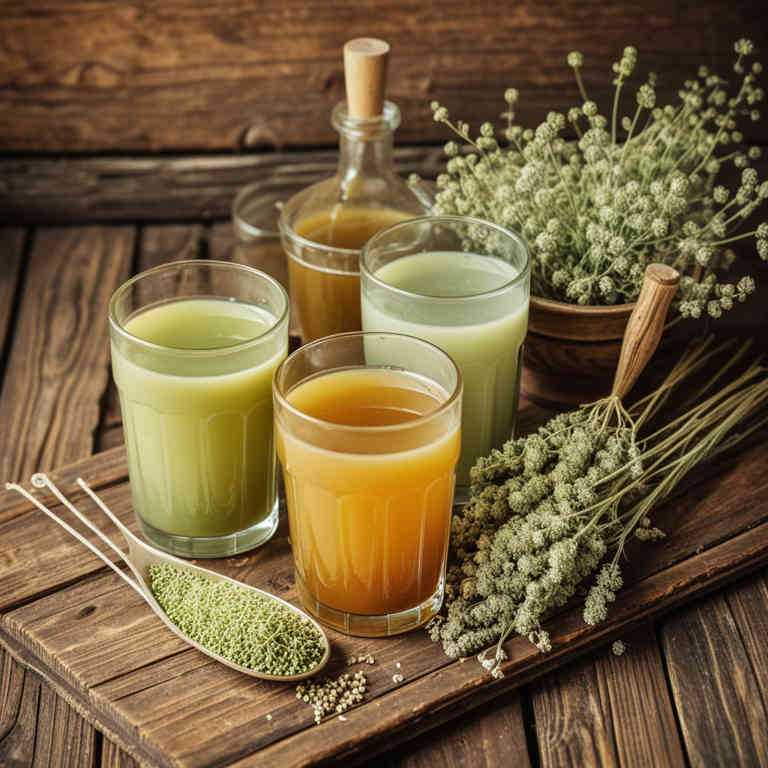
Lepidium meyenii herbal juices are used to support digestive health and enhance nutrient absorption due to their rich content of essential minerals and enzymes.
These juices are often consumed to alleviate gastrointestinal discomfort and promote regular bowel movements. They are also valued for their potential to reduce inflammation and support immune function. The unique compounds in lepidium meyenii, such as alkaloids and sulfur-containing amino acids, contribute to its therapeutic properties.
As a result, these juices are increasingly popular in holistic health practices for their natural and beneficial effects on the body.
46. Sanguisorba officinalis
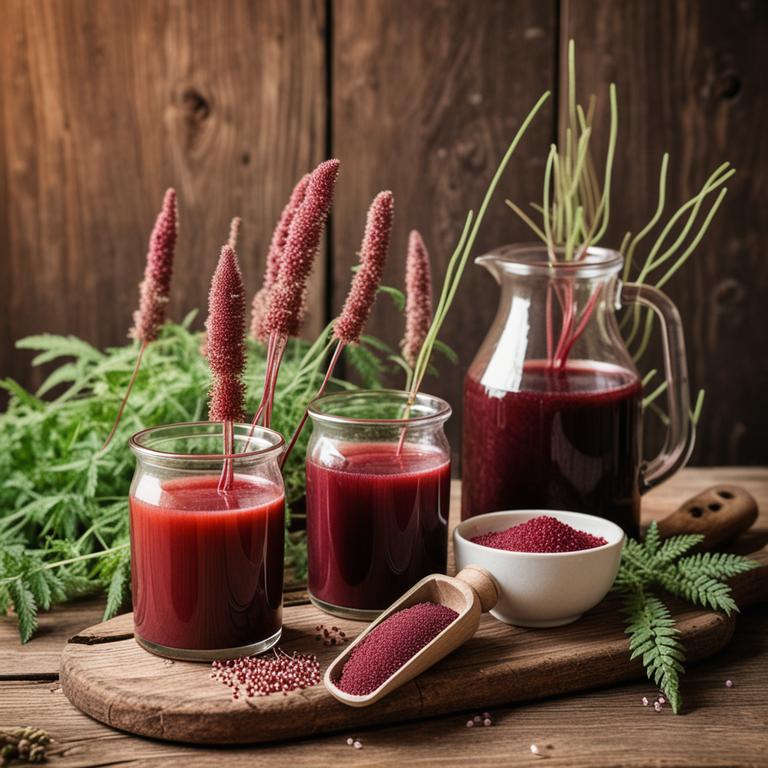
Sanguisorba officinalis herbal juices are used to support digestive health by stimulating the production of gastric juices and aiding in the digestion of food.
They are also valued for their diuretic properties, which help in the elimination of toxins and excess fluids from the body. The juice is believed to have a mild laxative effect, making it useful in treating constipation and promoting regular bowel movements. Additionally, it is used in traditional medicine to reduce inflammation and soothe skin conditions due to its anti-inflammatory compounds.
These benefits make sanguisorba officinalis a versatile herbal remedy with a range of applications in natural health practices.
47. Satureja hortensis
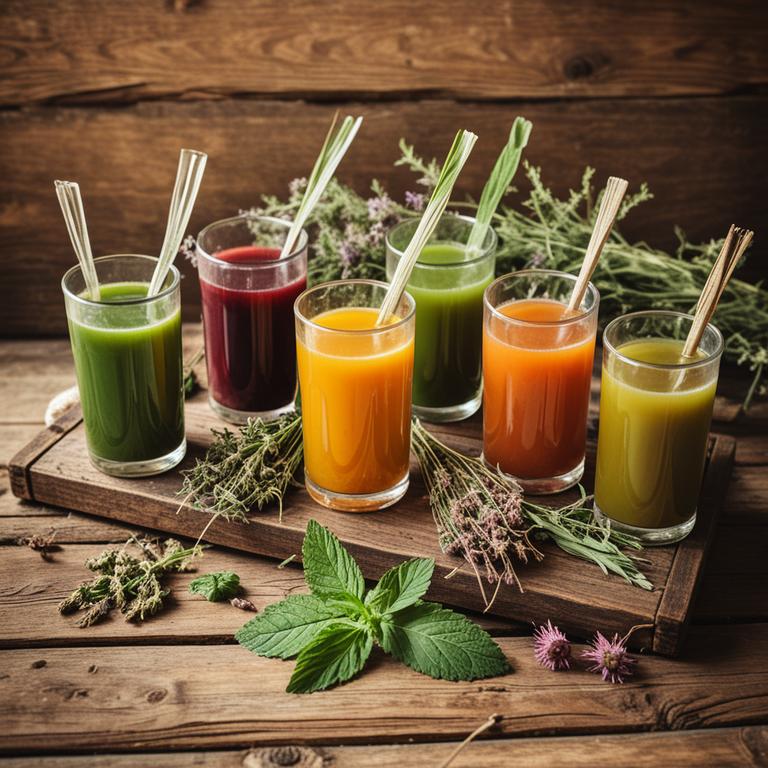
Satureja hortensis herbal juices are used to support digestive health by promoting the secretion of digestive enzymes and relieving gastrointestinal discomfort.
They are also valued for their antimicrobial properties, which can help in reducing harmful bacteria in the gut. These juices are often incorporated into herbal remedies to alleviate symptoms of indigestion, bloating, and flatulence. Additionally, they are believed to have a calming effect on the nervous system, making them useful in stress-related digestive issues.
Due to their mild and soothing nature, satureja hortensis herbal juices are a popular choice for those seeking natural support for their digestive wellness.
48. Moringa oleifera
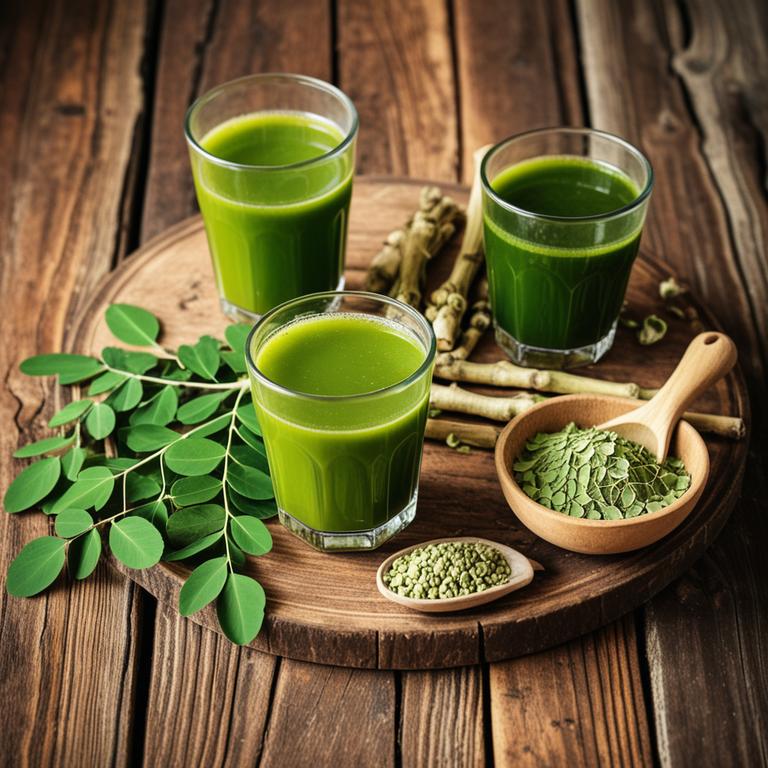
Moringa oleifera herbal juices are used to enhance overall health and well-being due to their rich nutritional profile.
These juices are known for their high content of vitamins, minerals, and antioxidants, which help in boosting the immune system and fighting oxidative stress. They are also used to support digestion and improve gut health because of their detoxifying properties. Additionally, moringa juice is popular for its potential role in managing blood sugar levels and promoting skin health.
Because of these benefits, moringa oleifera herbal juices are increasingly being incorporated into daily wellness routines around the world.
49. Nepeta cataria
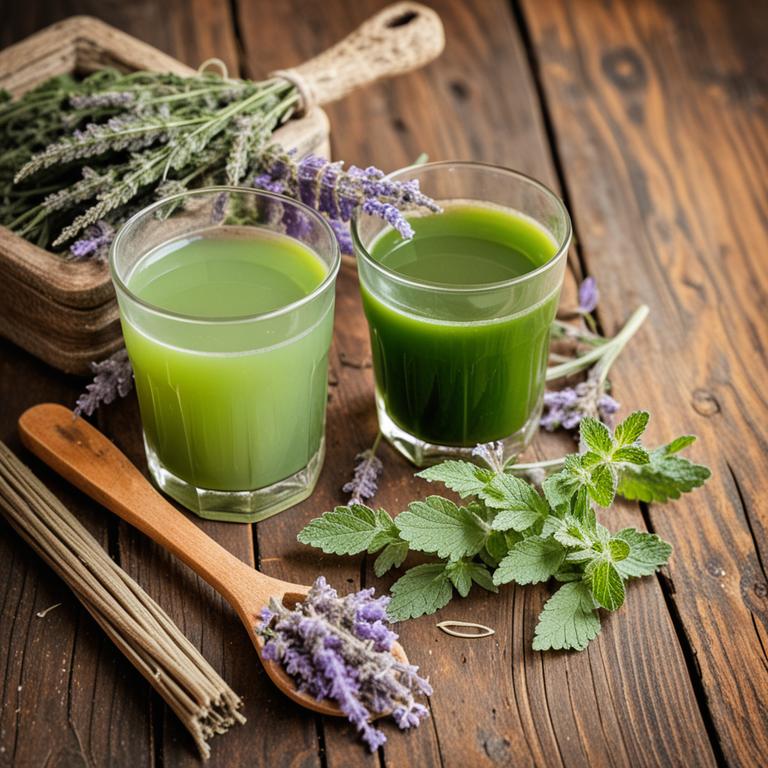
Nepeta cataria herbal juices are used to promote relaxation and reduce stress due to their calming properties.
These juices are often consumed as a natural remedy to alleviate anxiety and improve mood. They can also be applied topically to soothe skin irritations and reduce inflammation. The active compound nepetalactone in the juice is believed to interact with the central nervous system, contributing to its soothing effects.
Because of these benefits, nepeta cataria juices are increasingly popular in aromatherapy and holistic health practices.
50. Sutherlandia frutescens
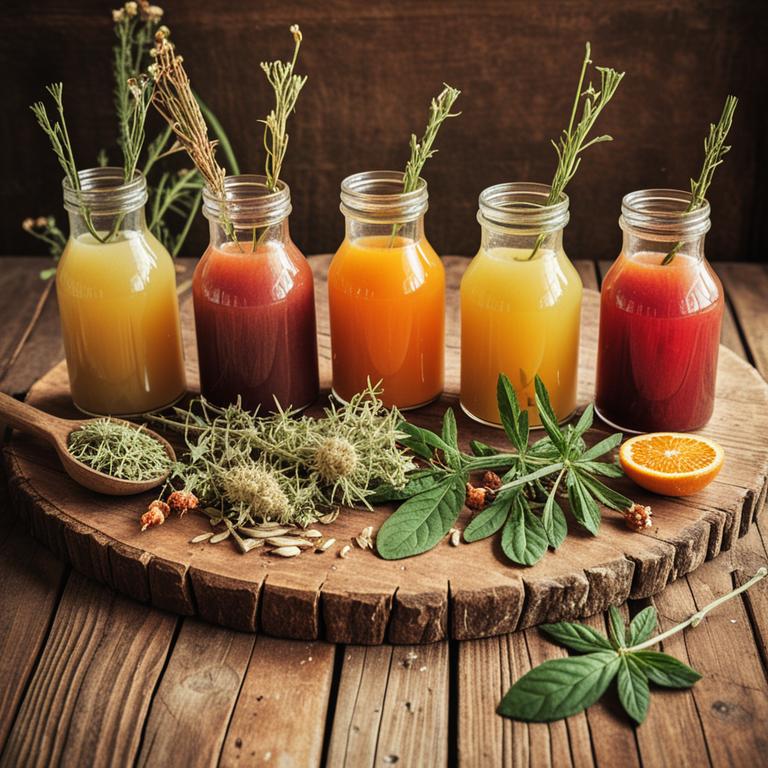
Sutherlandia frutescens herbal juices are used to support immune function and enhance overall vitality in individuals undergoing treatment for cancer.
These juices are believed to contain bioactive compounds that may help reduce fatigue and improve energy levels, making them a popular complementary therapy. They are also used to alleviate symptoms associated with chronic illnesses and promote a sense of well-being. The plant, known as "cancer bush," is traditionally used in African medicine for its purported restorative properties.
Due to their potential health benefits, sutherlandia frutescens herbal juices are increasingly sought after for their supportive role in holistic health approaches.
51. Tribulus terrestris
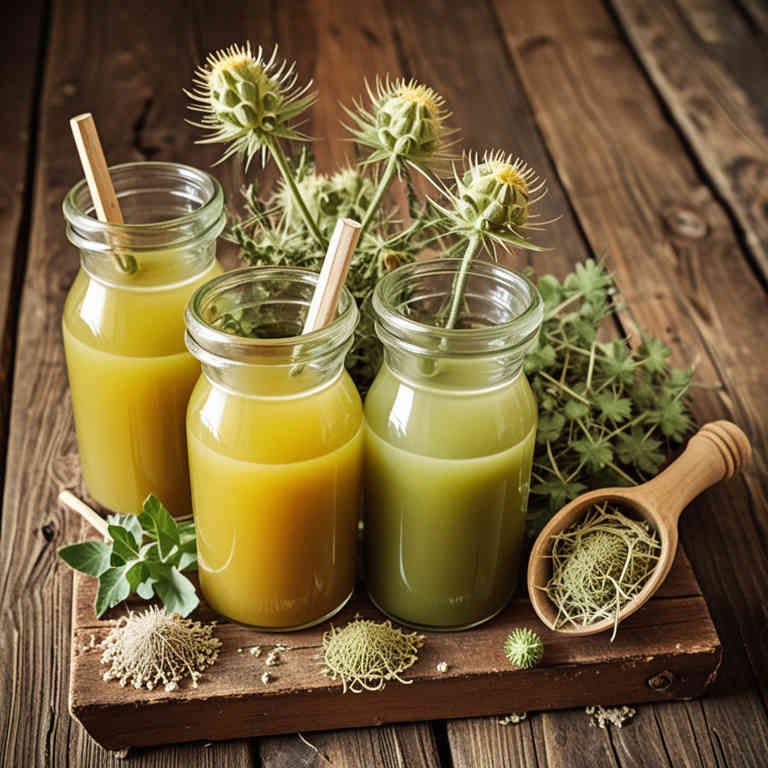
Tribulus terrestris herbal juices are used to enhance athletic performance and increase stamina by potentially boosting testosterone levels in the body.
They are also believed to support sexual health and improve libido in both men and women due to their phytochemical content. These juices may aid in muscle growth and recovery by promoting protein synthesis and reducing exercise-induced fatigue. Additionally, they are sometimes used to improve overall vitality and energy levels, making them popular among athletes and fitness enthusiasts.
The traditional use of tribulus terrestris in herbal medicine highlights its potential as a natural supplement for various health and wellness purposes.
52. Panax ginseng
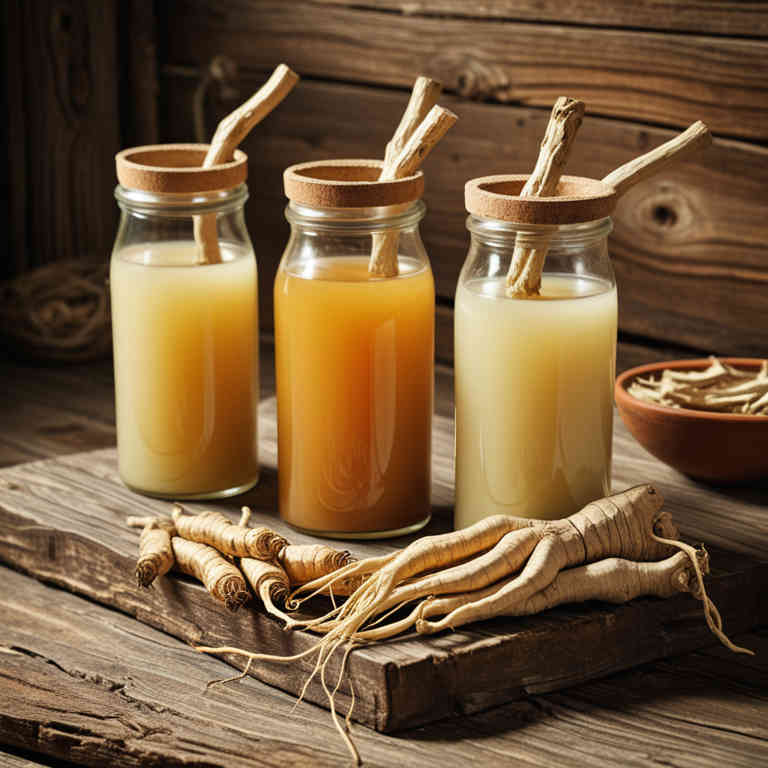
Panax ginseng herbal juices are used to enhance physical and mental performance by stimulating energy levels and improving focus.
These juices are believed to support the body's adaptation to stress, making them popular among individuals with demanding lifestyles. They are also used to boost the immune system and improve overall vitality, thanks to their rich content of ginsenosides and other bioactive compounds. Additionally, panax ginseng herbal juices may aid in cognitive function and memory retention, making them a favored supplement in traditional medicine.
Their long-standing use in both Eastern and Western health practices underscores their potential benefits for holistic well-being.
53. Hydrastis canadensis
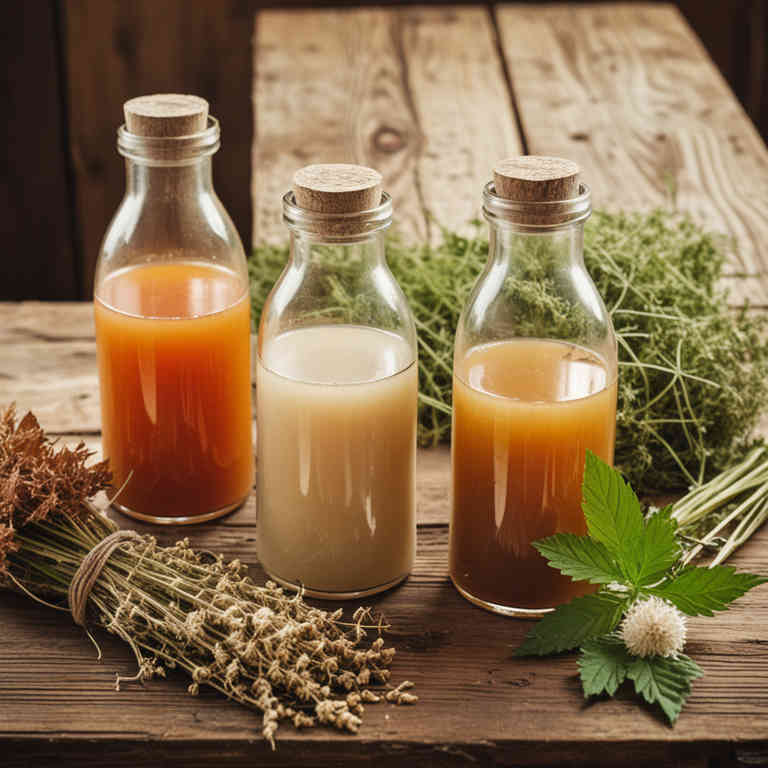
Hydrastis canadensis herbal juices are used to support digestive health by stimulating the production of digestive enzymes and promoting healthy gut flora.
They are also valued for their antimicrobial properties, which can help combat harmful bacteria and support immune function. These juices are often incorporated into traditional herbal remedies to aid in the treatment of skin conditions such as eczema and psoriasis due to their anti-inflammatory effects. Additionally, they are believed to enhance mental clarity and cognitive function, making them a popular choice in herbal medicine for improving focus and reducing mental fatigue.
The combination of these benefits makes hydrastis canadensis a versatile and valuable herbal remedy in both traditional and modern wellness practices.
54. Triticum aestivum
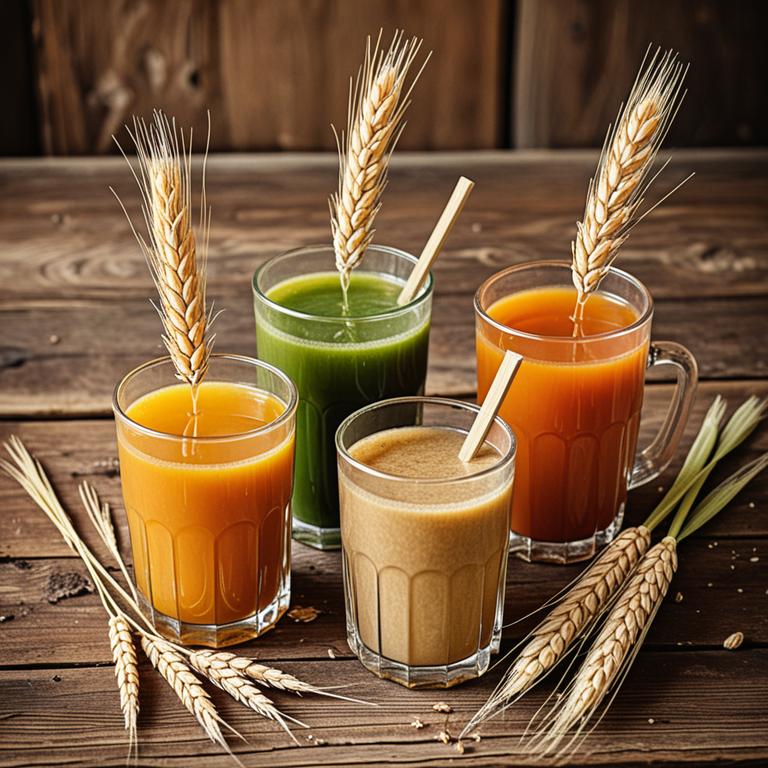
Triticum aestivum herbal juices are used to support digestive health by promoting the secretion of digestive enzymes and improving gut motility.
These juices are also beneficial for reducing inflammation in the gastrointestinal tract, which can help alleviate symptoms of conditions like irritable bowel syndrome. Additionally, they are rich in antioxidants, which help protect the body from oxidative stress and support overall immune function. The natural compounds in triticum aestivum juices may also aid in detoxification processes by supporting liver function.
Due to their nutrient density and therapeutic properties, these juices are increasingly incorporated into holistic wellness regimens for their potential health benefits.
55. Agrimonia eupatoria
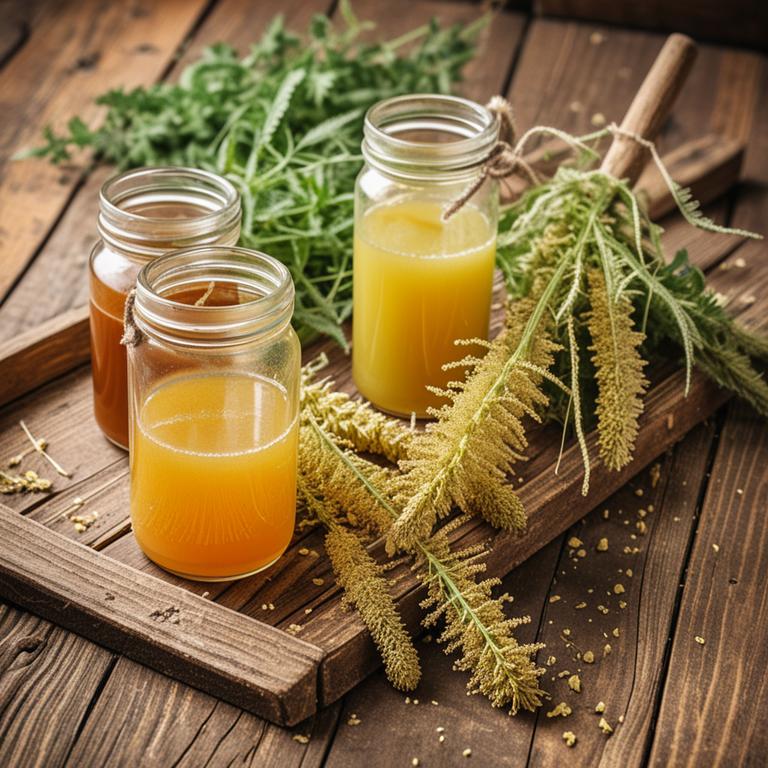
Agrimonia eupatoria herbal juices are used to support digestive health due to their high content of tannins and antioxidants, which can help soothe gastrointestinal discomfort and promote healthy digestion.
They are also valued for their anti-inflammatory properties, making them beneficial for reducing inflammation in the digestive tract and supporting overall gut health. Additionally, these juices are often used to alleviate symptoms of mild gastrointestinal disorders such as indigestion and bloating. The presence of flavonoids and other bioactive compounds contributes to their ability to protect the stomach lining and enhance nutrient absorption.
Overall, agrimonia eupatoria herbal juices are favored in traditional and complementary medicine for their natural, holistic approach to improving digestive wellness.
56. Calendula officinalis
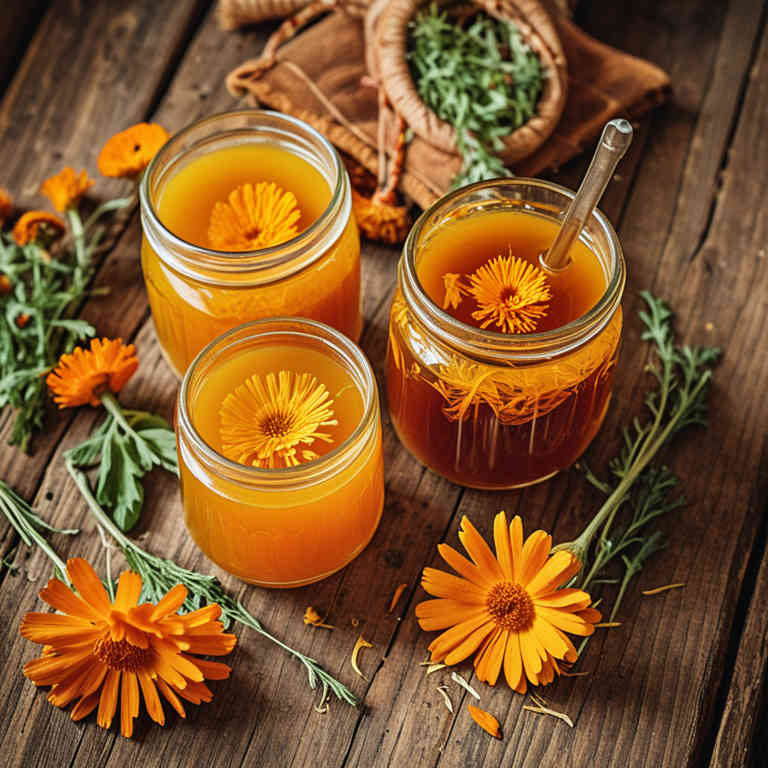
Calendula officinalis herbal juices are used to promote skin health and treat various dermatological conditions due to their anti-inflammatory and antimicrobial properties.
These juices can help soothe irritated skin, reduce redness, and accelerate the healing of minor wounds and burns. They are also beneficial in managing eczema and psoriasis by calming skin inflammation and enhancing skin regeneration. The presence of flavonoids and triterpenes in the juice contributes to its effectiveness in protecting the skin from oxidative stress.
Because of these benefits, calendula officinalis herbal juices are widely used in natural skincare products and traditional medicine practices.
57. Tamarindus indica

Tamarindus indica herbal juices are used to support digestive health due to their high content of organic acids, which can stimulate the production of digestive enzymes.
They are also beneficial for reducing inflammation and alleviating symptoms of conditions like arthritis because of their anti-inflammatory properties. These juices may aid in weight management by promoting a feeling of fullness and supporting metabolic functions. Additionally, they are used in traditional medicine to treat colds and respiratory infections due to their antimicrobial and antioxidant effects.
Overall, tamarindus indica herbal juices are valued for their versatility and potential health benefits across various bodily systems.
58. Leonurus cardiaca
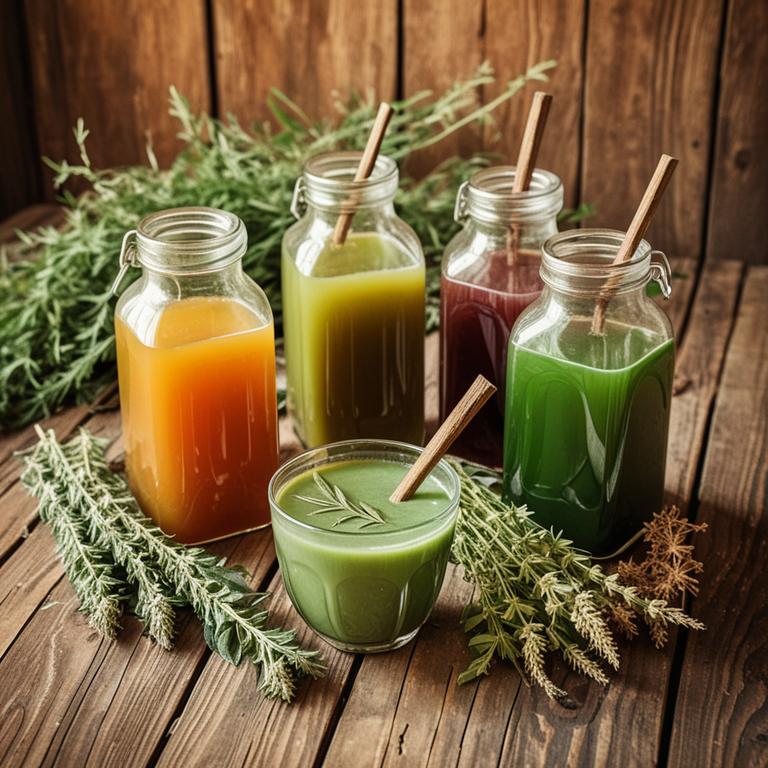
Leonurus cardiaca herbal juices are used to support cardiovascular health due to their rich content of antioxidants and bioactive compounds.
These juices are believed to help regulate blood pressure and improve circulation, making them beneficial for individuals with hypertension or circulatory issues. The plant, also known as heart herb, has been traditionally used in herbal medicine to strengthen the heart muscle and promote overall cardiac function. Its anti-inflammatory properties may also contribute to reducing oxidative stress in the body.
Because of these potential benefits, leonurus cardiaca herbal juices are increasingly being explored as a natural supplement for heart-related wellness.
59. Echinacea angustifolia
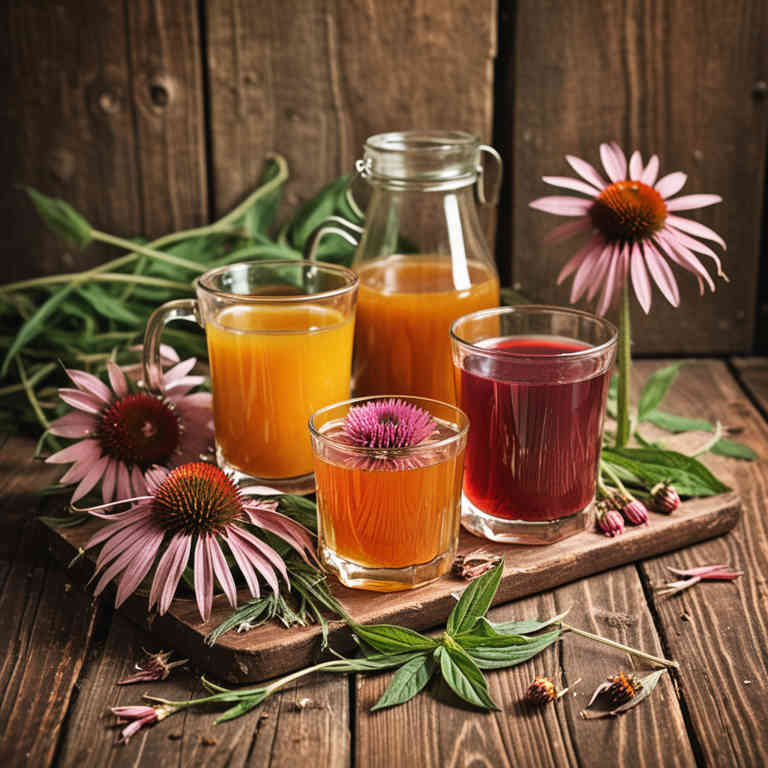
Echinacea angustifolia herbal juices are used to boost the immune system and reduce the duration of colds and flu.
These juices contain compounds like alkamides, caffeic acid derivatives, and polysaccharides that have anti-inflammatory and immunostimulant properties. They are often consumed as a natural remedy to prevent or alleviate symptoms of respiratory infections. The active components in echinacea angustifolia help enhance the body's natural defenses against pathogens.
Due to their safety profile and effectiveness, they are widely used in herbal medicine and wellness practices.
60. Artemisia vulgaris
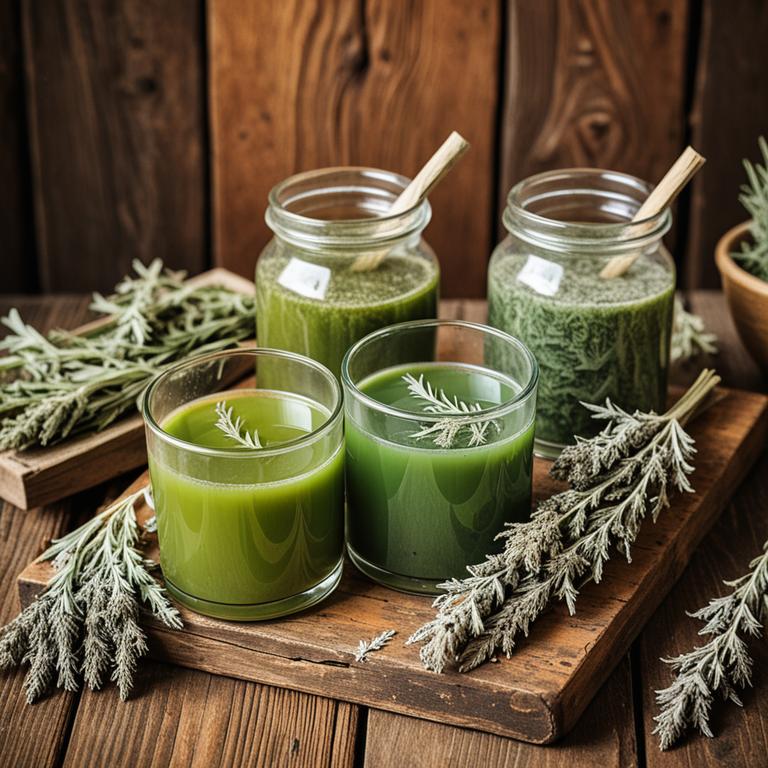
Artemisia vulgaris herbal juices are used to support digestive health by stimulating the production of digestive enzymes and relieving symptoms of indigestion and bloating.
They are also valued for their antimicrobial properties, which can help in fighting off infections and promoting overall gut health. Additionally, these juices are believed to have a calming effect on the nervous system, making them useful in reducing stress and anxiety. In traditional medicine, artemisia vulgaris has been used to treat fevers and respiratory conditions due to its fever-reducing and expectorant qualities.
The combination of these health benefits makes artemisia vulgaris herbal juices a versatile and valuable natural remedy in holistic wellness practices.
61. Vaccinium myrtillus
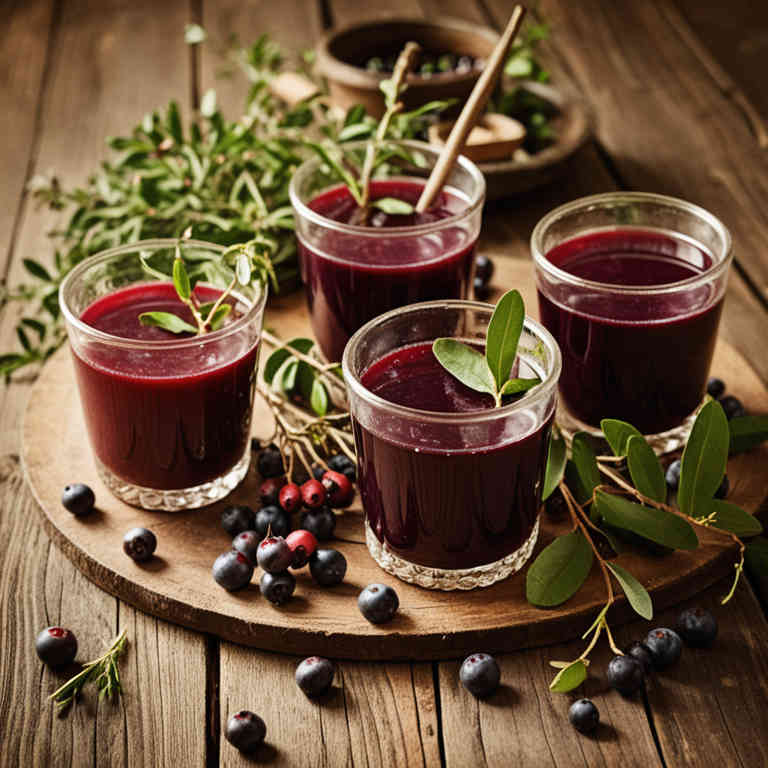
Vaccinium myrtillus herbal juices are used to support respiratory health by alleviating symptoms of coughs and colds due to their antimicrobial and anti-inflammatory properties.
These juices are also valued for their ability to boost the immune system, making them beneficial during seasonal changes when the body is more susceptible to infections. The presence of antioxidants in vaccinium myrtillus helps neutralize free radicals, promoting overall cellular health and reducing oxidative stress. Additionally, the juice is sometimes used topically to soothe skin irritations and promote wound healing because of its soothing and regenerative effects.
Overall, the versatility of vaccinium myrtillus herbal juices makes them a valuable natural remedy in both internal and external applications.
62. Boswellia serrata
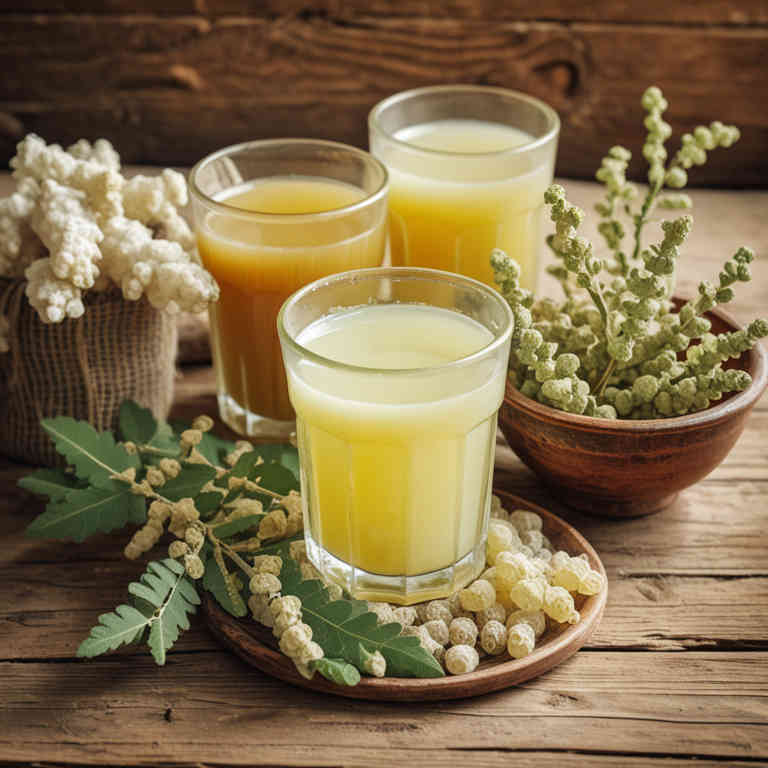
Boswellia serrata herbal juices are used to support joint health and reduce inflammation due to their high concentration of active compounds like boswellic acids.
These compounds work by inhibiting enzymes that contribute to inflammatory responses in the body, making them beneficial for individuals suffering from arthritis and other inflammatory conditions. Additionally, boswellia serrata juices may aid in improving respiratory function by reducing airway inflammation, which can help alleviate symptoms of asthma and chronic bronchitis. The herb is also valued for its potential to enhance cognitive function and reduce stress, thanks to its anti-inflammatory and neuroprotective properties.
Overall, boswellia serrata herbal juices are a natural remedy that offers a range of health benefits, particularly for those seeking alternatives to conventional anti-inflammatory treatments.
63. Rhodiola rosea
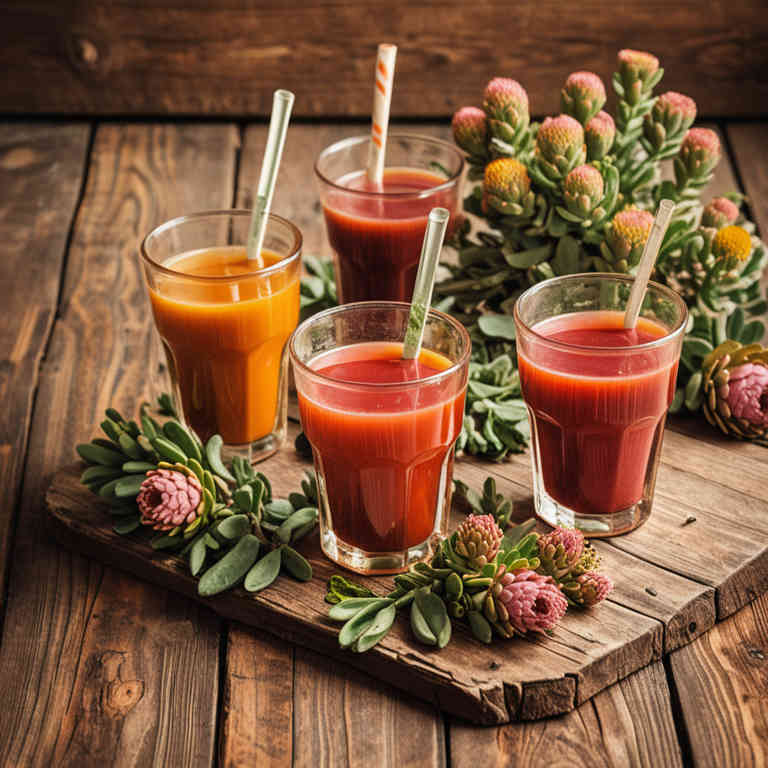
Rhodiola rosea herbal juices are used to enhance physical and mental performance by supporting energy levels and reducing fatigue.
These juices are particularly beneficial for individuals experiencing stress, as they help the body adapt to challenging conditions through their adaptogenic properties. They are also known to improve cognitive function, making them popular among students and professionals seeking mental clarity and focus. Additionally, rhodiola rosea juices may support immune function and promote overall well-being by balancing the body's stress response.
Due to their natural composition and wide range of benefits, these juices are increasingly being incorporated into wellness routines for both preventative and therapeutic purposes.
64. Taraxacum officinale
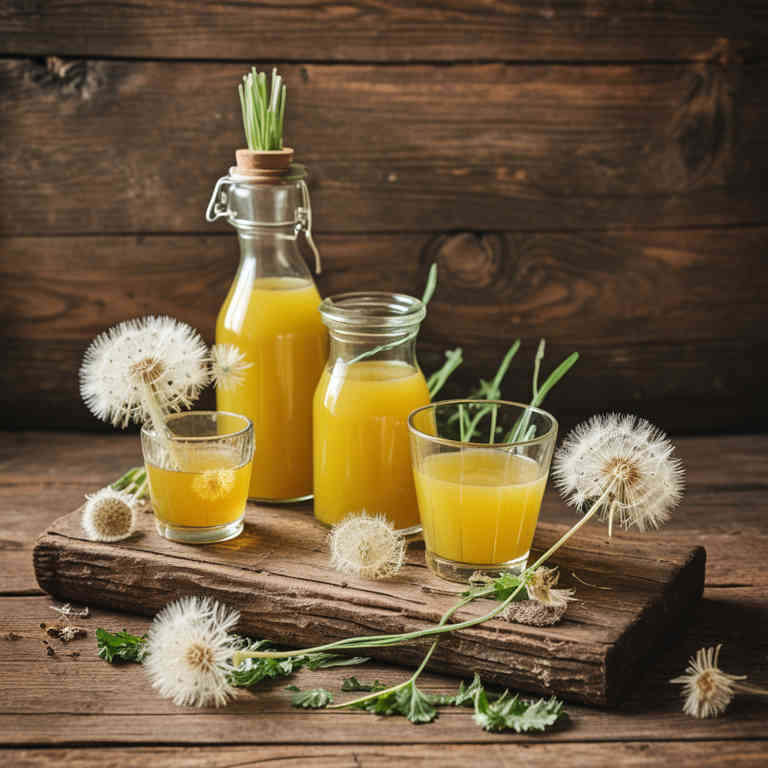
Taraxacum officinale herbal juices are used to support digestive health due to their mild laxative properties, which can help relieve constipation and promote regular bowel movements.
These juices are also valued for their diuretic effects, aiding in the removal of toxins and excess fluids from the body. Additionally, they contain compounds that may help reduce inflammation, making them beneficial for conditions like arthritis or skin disorders. The presence of vitamins and minerals in dandelion juice also contributes to its role in boosting the immune system and supporting liver function.
Overall, taraxacum officinale herbal juices are prized for their natural cleansing properties and their ability to enhance overall wellness.
65. Valeriana officinalis
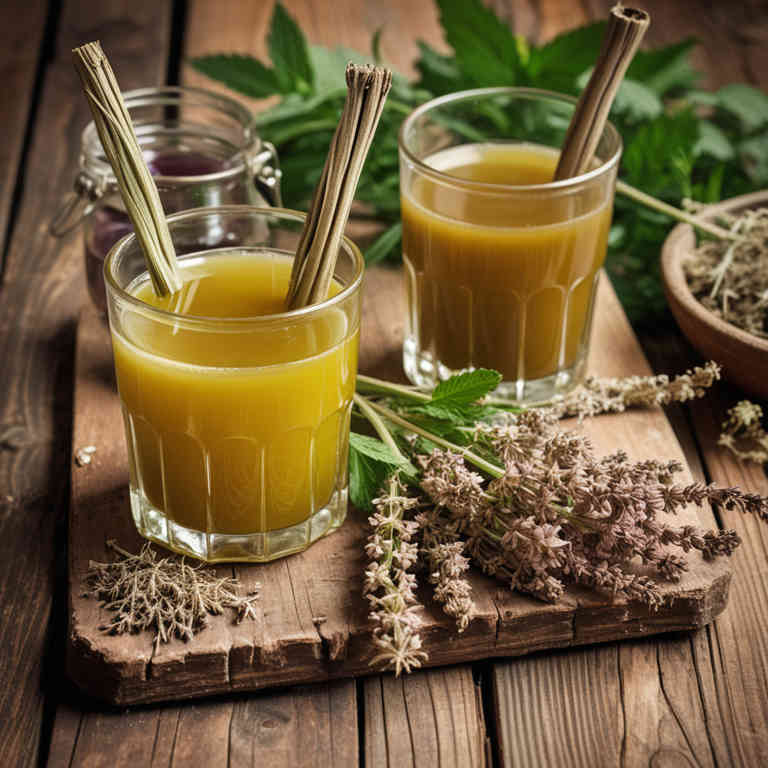
Valeriana officinalis herbal juices are used to promote relaxation and alleviate symptoms of anxiety and insomnia.
These juices contain compounds like valerenic acid, which interact with the brain's GABA receptors to reduce neural activity and induce a calming effect. They are also utilized in traditional medicine to treat digestive issues such as bloating and stomach cramps. The soothing properties of valeriana officinalis make it a popular choice for natural remedies in stress management and sleep enhancement.
Due to its mild side effects compared to pharmaceutical alternatives, it is often recommended for those seeking holistic approaches to mental and physical well-being.
66. Vitex negundo
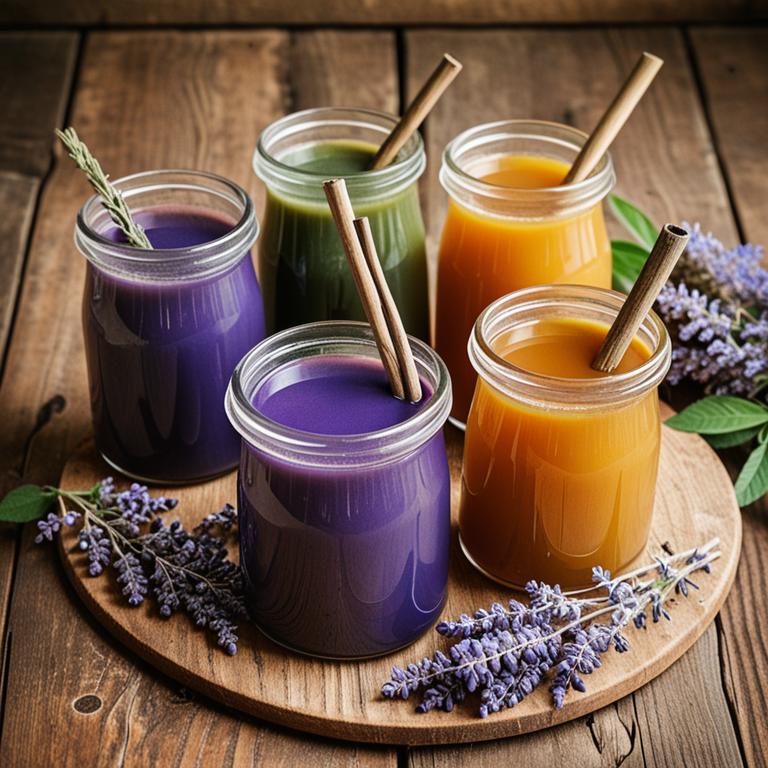
Vitex negundo herbal juices are used to support hormonal balance and improve reproductive health, particularly in women.
They are traditionally believed to enhance fertility and regulate menstrual cycles by influencing the pituitary gland. The juice is also utilized in treating skin conditions and reducing inflammation due to its antioxidant properties. It has been incorporated into herbal medicine for its calming effects on the nervous system.
These benefits make vitex negundo a valuable remedy in both traditional and modern holistic health practices.
67. Ocimum basilicum

Ocimum basilicum herbal juices are used to promote digestive health by stimulating the production of digestive enzymes and easing gastrointestinal discomfort.
They are also valued for their ability to reduce stress and anxiety due to their calming effects on the nervous system. These juices are often incorporated into skincare routines to help soothe skin irritations and reduce inflammation. Additionally, they are believed to enhance cognitive function and improve memory, making them popular in traditional medicine practices.
The wide range of health benefits attributed to ocimum basilicum herbal juices highlights their significance in both culinary and medicinal applications.
68. Plantago lanceolata
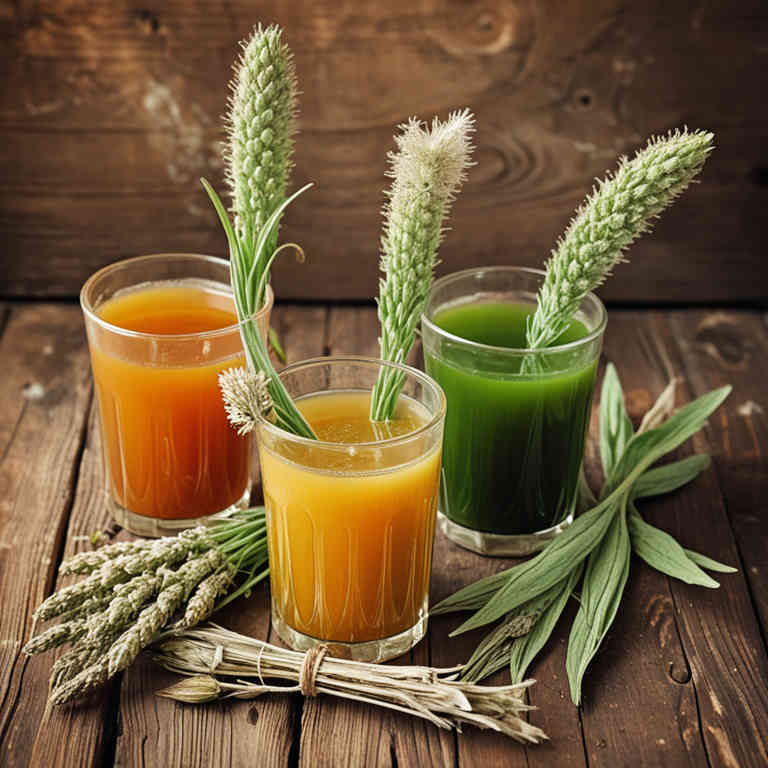
Plantago lanceolata herbal juices are used to support respiratory health by helping to alleviate symptoms of coughs, bronchitis, and asthma due to their expectorant properties.
These juices are also beneficial for digestive wellness, as they can soothe inflammation in the gastrointestinal tract and promote healthy digestion. Additionally, they are valued for their anti-inflammatory effects, which can help reduce swelling and irritation in various parts of the body. The presence of mucilage in the plant contributes to its soothing qualities, making it useful for treating sore throats and skin irritations.
Overall, plantago lanceolata herbal juices are prized for their natural ability to support overall health and well-being through their diverse therapeutic properties.
69. Symphytum officinale
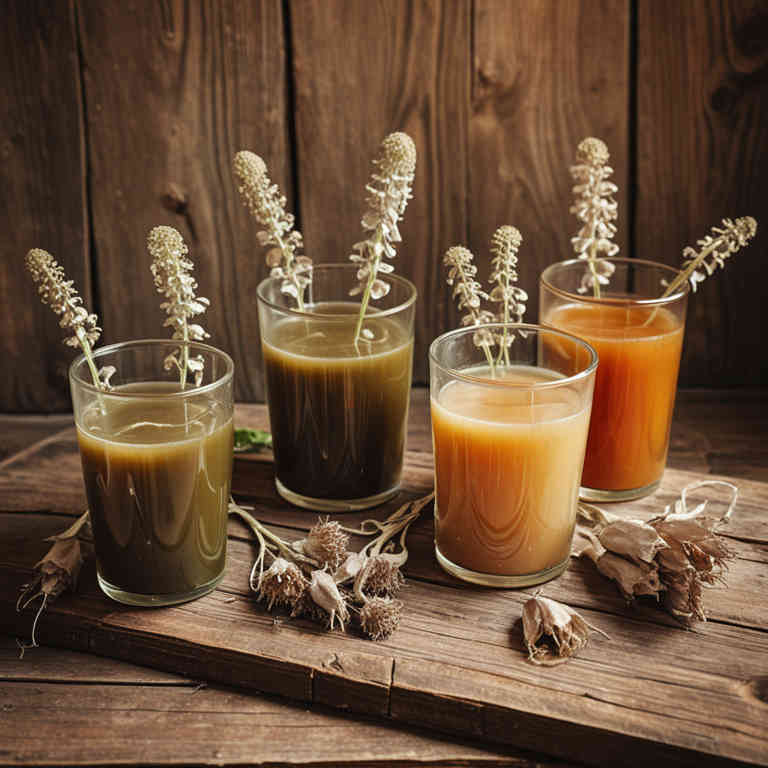
Symphytum officinale herbal juices are used to promote bone healing and reduce inflammation in the body.
They contain compounds such as allantoin and mucilage, which have soothing and regenerative properties that support tissue repair. These juices are often applied topically to treat bruises, sprains, and other minor injuries due to their ability to alleviate pain and swelling. Additionally, they may aid in the treatment of skin conditions like eczema and psoriasis by calming irritated skin.
Their historical use in traditional medicine highlights their potential as a natural remedy for various health concerns.
70. Paeonia suffruticosa
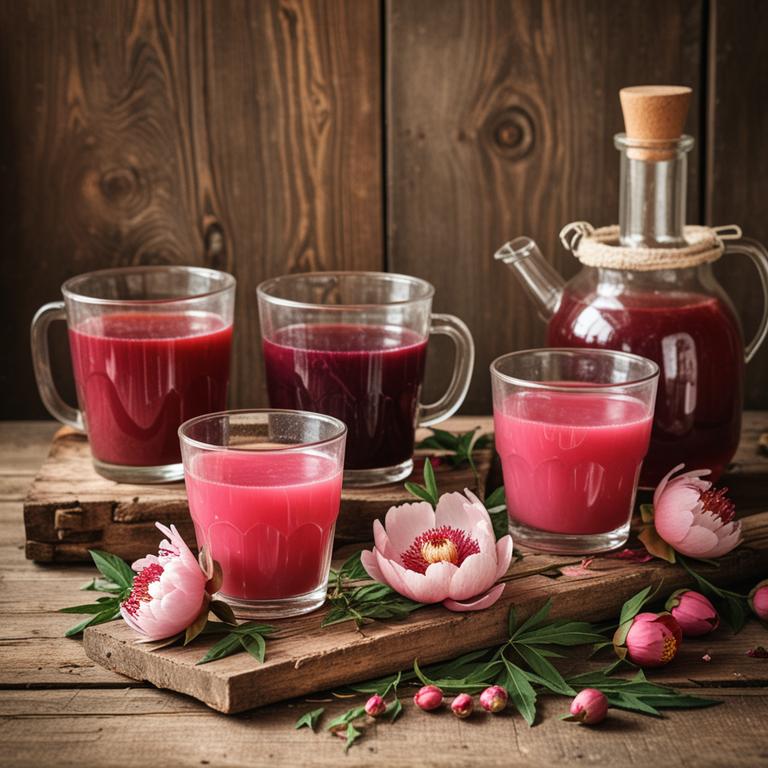
Paeonia suffruticosa herbal juices are used to support digestive health and promote detoxification by aiding in the elimination of toxins from the body.
These juices are rich in antioxidants, which help combat oxidative stress and reduce inflammation, making them beneficial for overall wellness. They are also valued in traditional medicine for their potential to alleviate symptoms of respiratory conditions such as coughs and bronchitis. The unique compounds in paeonia suffruticosa may contribute to its calming effects, supporting mental clarity and stress relief.
Due to these multiple health benefits, paeonia suffruticosa herbal juices are increasingly sought after in both traditional and modern wellness practices.
71. Artemisia annua
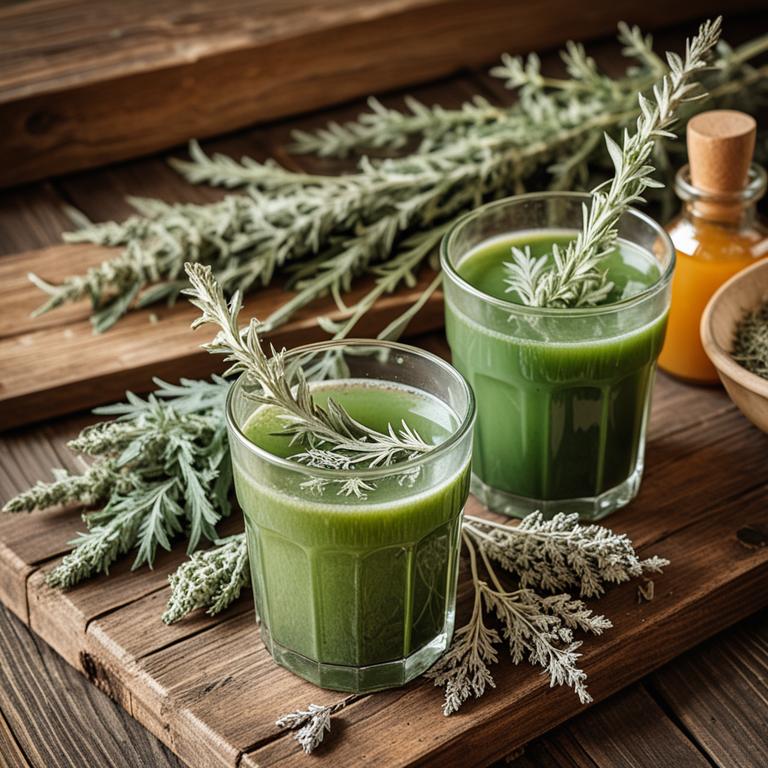
Artemisia annua herbal juices are used to treat malaria due to their high concentration of artemisinin, a compound known for its potent antimalarial properties.
These juices have also shown potential in reducing fever and inflammation, making them beneficial for individuals suffering from infectious diseases and inflammatory conditions. In traditional Chinese medicine, artemisia annua has been utilized for centuries to support immune function and detoxification processes in the body. Modern research continues to explore its applications in cancer treatment and as a complementary therapy for various health issues.
The use of artemisia annua herbal juices is supported by both historical practices and contemporary scientific studies, highlighting its significance in natural medicine.
72. Cyperus rotundus
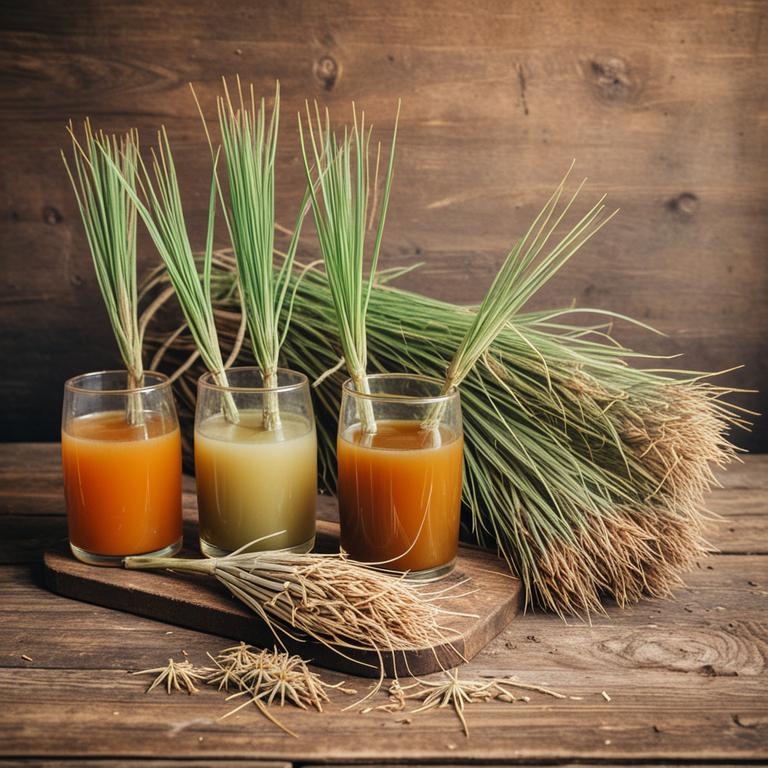
Cyperus rotundus herbal juices are used to promote digestive health and alleviate gastrointestinal discomfort.
These juices contain bioactive compounds that help stimulate digestion and reduce symptoms such as bloating and indigestion. They are also known to support liver function by aiding in the detoxification process. Additionally, the anti-inflammatory properties of Cyperus rotundus juices can help in managing conditions like gastritis and ulcers.
Due to their natural and holistic benefits, these juices are increasingly being incorporated into traditional and modern herbal remedies for overall wellness.
73. Ocimum sanctum
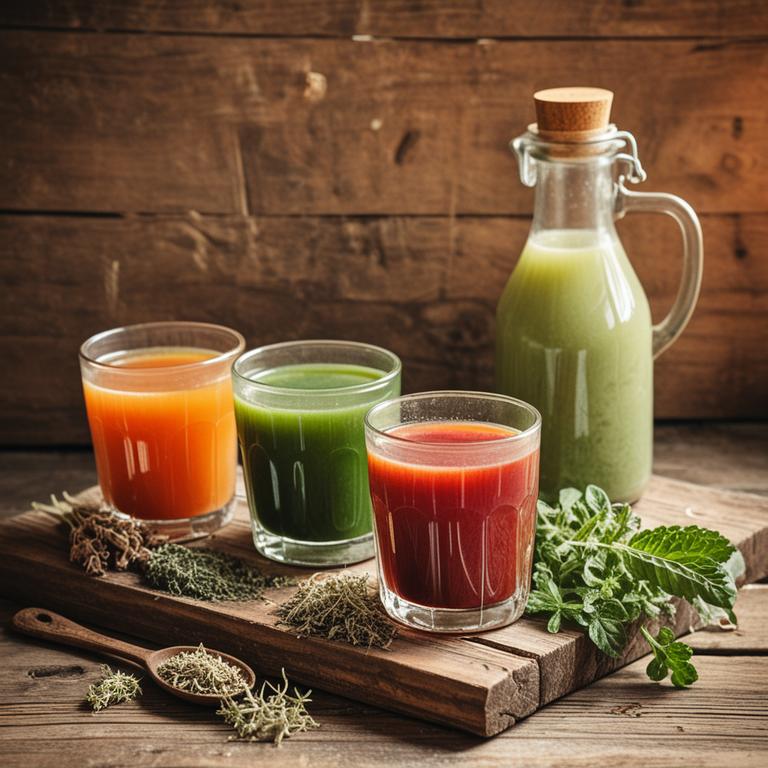
Ocimum sanctum herbal juices are used to promote overall health and well-being due to their rich content of antioxidants, vitamins, and minerals.
These juices are known to support the immune system by enhancing the body's natural defenses against infections and diseases. They are also utilized to reduce inflammation and alleviate symptoms of respiratory conditions such as asthma and cough. Additionally, ocimum sanctum juices are believed to aid in digestion and improve metabolic functions, contributing to better energy levels and vitality.
Their versatility makes them a valuable addition to both traditional and modern health practices.
74. Avena sativa
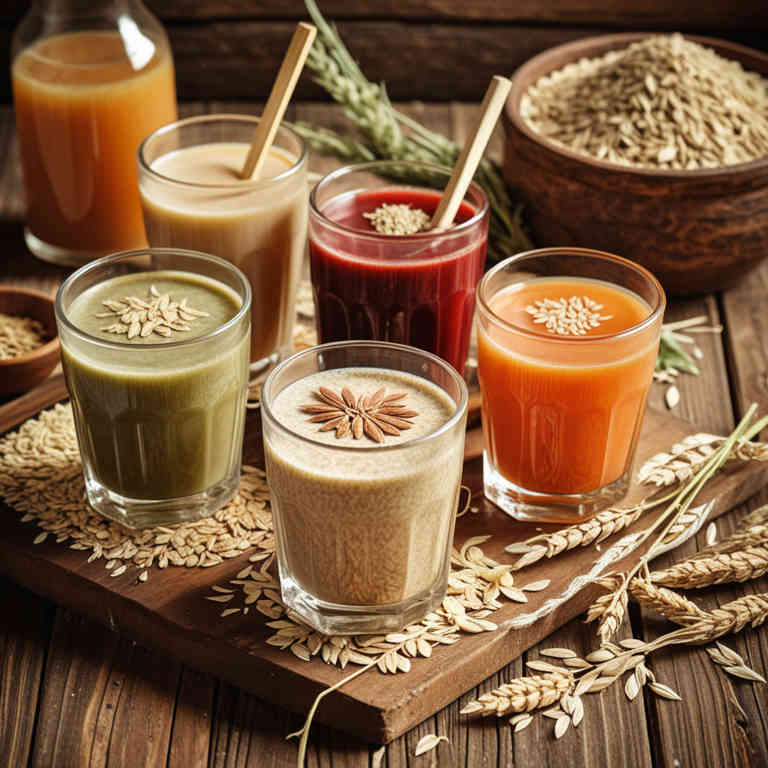
Avena sativa herbal juices are used to promote overall wellness and support various bodily functions.
They are particularly valued for their high nutrient content, including vitamins, minerals, and amino acids, which contribute to improved digestion and nutrient absorption. These juices are also known to help reduce stress and anxiety due to their calming properties, making them a popular choice for those seeking natural relaxation. Additionally, they are used to enhance energy levels and support immune function, thanks to their rich antioxidant profile.
Overall, avena sativa herbal juices offer a natural and holistic approach to health maintenance and wellness.
75. Cymbopogon martinii

Cymbopogon martinii herbal juices are used to promote relaxation and reduce stress due to their calming properties.
These juices are also known to support digestive health by aiding in the relief of indigestion and bloating. The essential oils derived from the plant are often used in aromatherapy to enhance mood and alleviate anxiety. Additionally, they are believed to have antioxidant properties that help in boosting the immune system.
Because of these benefits, cymbopogon martinii herbal juices are increasingly popular in natural wellness and holistic health practices.
76. Anethum graveolens
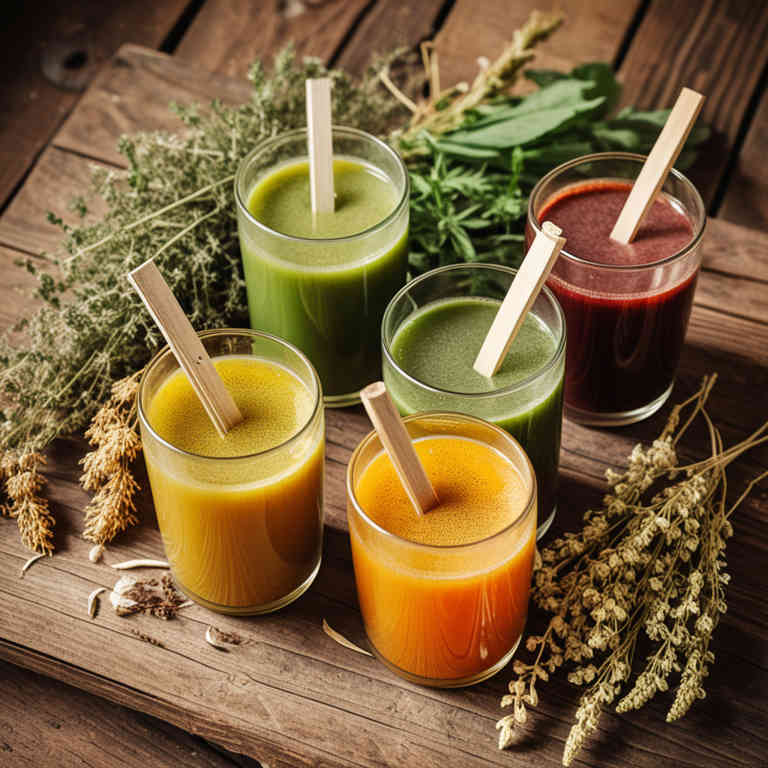
Anethum graveolens herbal juices are used to aid digestion and relieve gastrointestinal discomfort due to their carminative properties.
These juices help in reducing bloating, gas, and indigestion by stimulating the digestive system and promoting the release of digestive enzymes. They are also known to have anti-inflammatory effects, which can soothe the lining of the stomach and intestines. Additionally, the essential oils in the juice contribute to its ability to alleviate nausea and vomiting.
Because of these benefits, anethum graveolens herbal juices are widely used in traditional medicine and natural remedies for digestive health.
77. Plantago ovata
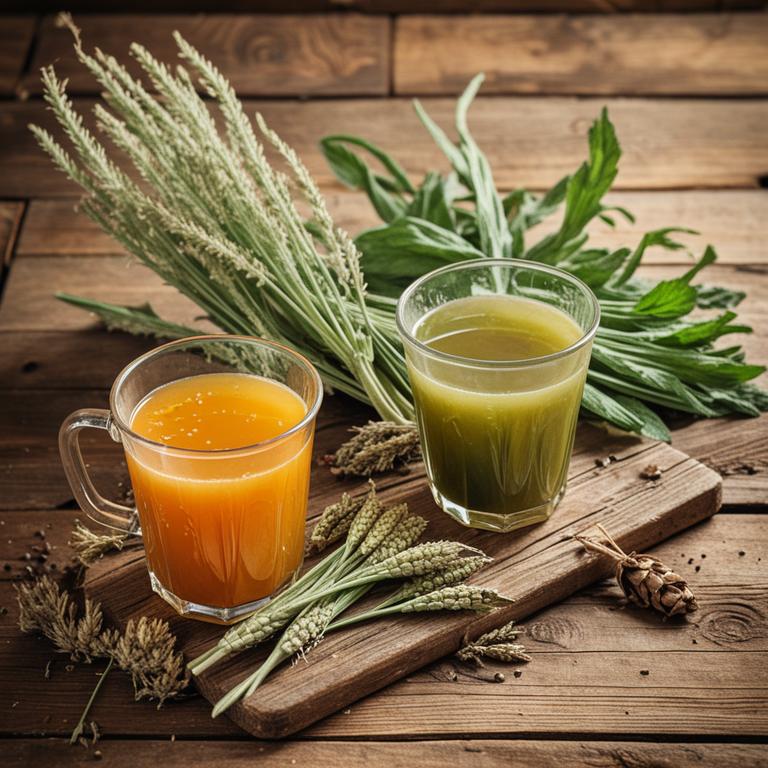
Plantago ovata herbal juices are used to promote digestive health by aiding in the relief of constipation due to their high mucilage content, which absorbs water and softens stool.
They are also valued for their ability to reduce inflammation and support overall gastrointestinal function, making them beneficial for individuals with digestive disorders. Additionally, these juices are known to help in detoxifying the body by supporting liver function and removing toxins. Their mild and soothing properties make them suitable for regular consumption without causing significant side effects.
Overall, plantago ovata herbal juices are a natural and effective remedy for maintaining a healthy digestive system and enhancing overall well-being.
78. Solanum tuberosum

Solanum tuberosum herbal juices are used to support digestive health due to their high concentration of bioactive compounds.
These juices are believed to aid in the treatment of gastrointestinal disorders such as indigestion and bloating by stimulating enzyme production. Additionally, they are used to enhance immune function because of their antioxidant properties, which help neutralize harmful free radicals in the body. The anti-inflammatory effects of these juices also make them useful in managing conditions like arthritis and skin inflammation.
Overall, solanum tuberosum herbal juices are valued for their potential therapeutic benefits in promoting overall wellness and natural healing.
79. Pueraria lobata
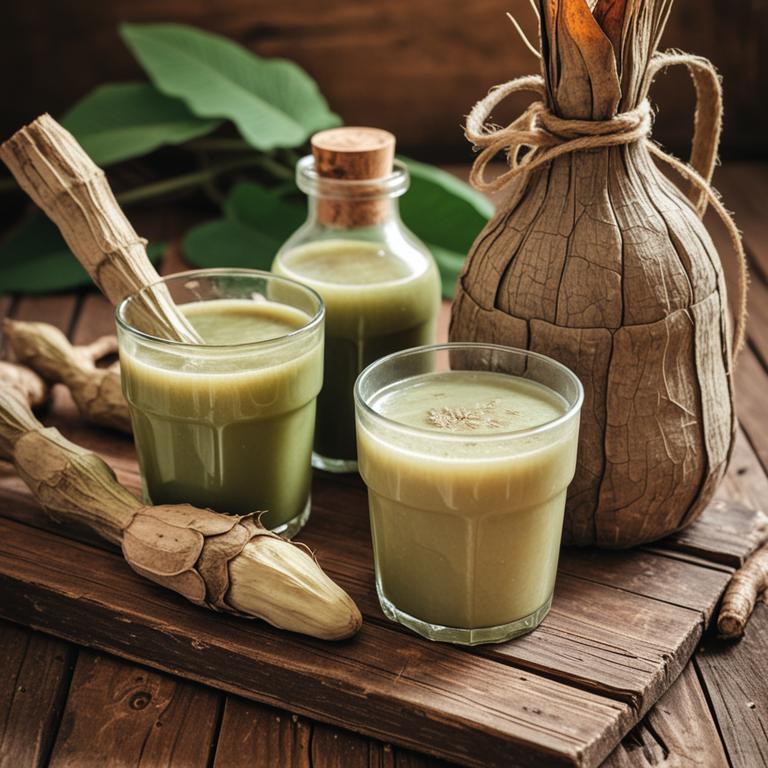
Pueraria lobata herbal juices are used to support weight loss and metabolic health due to their high content of isoflavones, which may help regulate fat metabolism.
These juices are also valued for their potential to alleviate menopausal symptoms by balancing hormone levels, particularly estrogen. In traditional medicine, they are often used to improve circulation and reduce inflammation, promoting overall wellness. The antioxidant properties of pueraria lobata may contribute to its role in supporting cardiovascular health and preventing oxidative stress.
Overall, these herbal juices are gaining popularity for their natural approach to enhancing health and managing various physiological conditions.
80. Rhus toxicaria

Rhus toxicaria herbal juices are used to treat skin conditions such as eczema, psoriasis, and rashes due to their anti-inflammatory and astringent properties.
These juices are also valued for their ability to alleviate joint pain and stiffness, making them useful in the management of arthritis and rheumatic disorders. The active compounds in Rhus toxicaria help to reduce redness, itching, and irritation, promoting skin healing and comfort. Additionally, the juice is sometimes used in homeopathic remedies to address allergic reactions and respiratory issues.
Because of its potent healing properties, Rhus toxicaria herbal juice is often incorporated into traditional herbal medicine practices for its broad range of therapeutic benefits.
81. Withania somnifera

Withania somnifera herbal juices are used to support overall health and well-being by promoting relaxation and reducing stress.
These juices are rich in bioactive compounds such as alkaloids and steroidal lactones, which have adaptogenic properties that help the body manage stress more effectively. They are also known to enhance cognitive function and improve sleep quality, making them beneficial for individuals experiencing fatigue or insomnia. Additionally, the anti-inflammatory and antioxidant properties of these juices contribute to immune system support and cellular protection.
Due to their wide range of health benefits, withania somnifera herbal juices are increasingly being incorporated into holistic wellness practices and natural remedies.
82. Carum carvi
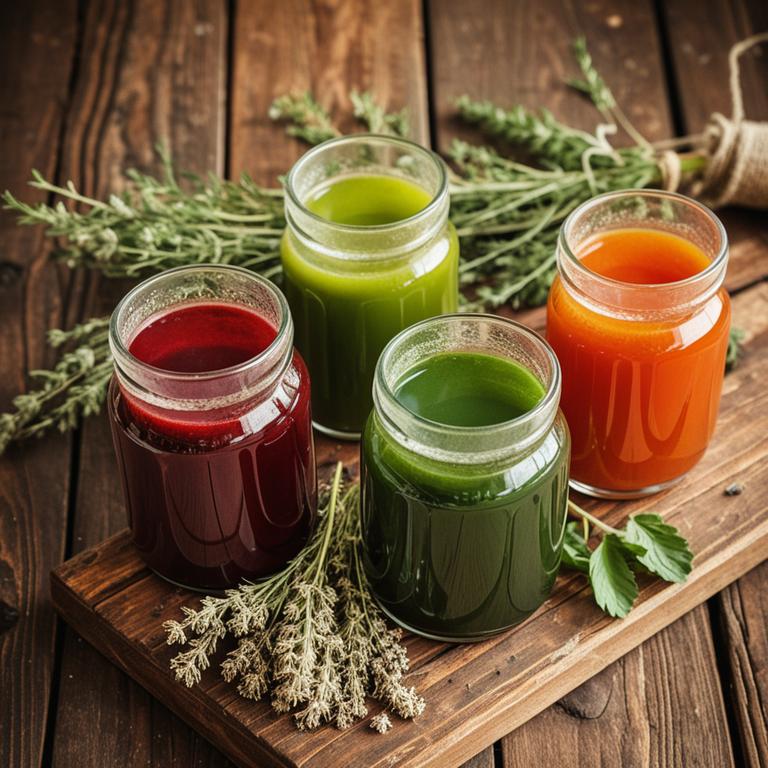
Carum carvi herbal juices are used to support digestive health by stimulating the production of digestive enzymes and relieving symptoms of indigestion and bloating.
They are also valued for their ability to alleviate respiratory issues such as coughs and congestion due to their expectorant properties. The juice of carum carvi is known to have antimicrobial effects, making it useful in treating mild infections and supporting immune function. Additionally, it is often used in traditional medicine to reduce inflammation and soothe skin irritations when applied topically.
These benefits are attributed to the presence of essential oils like carvone and limonene, which contribute to its therapeutic properties.
83. Althaea officinalis
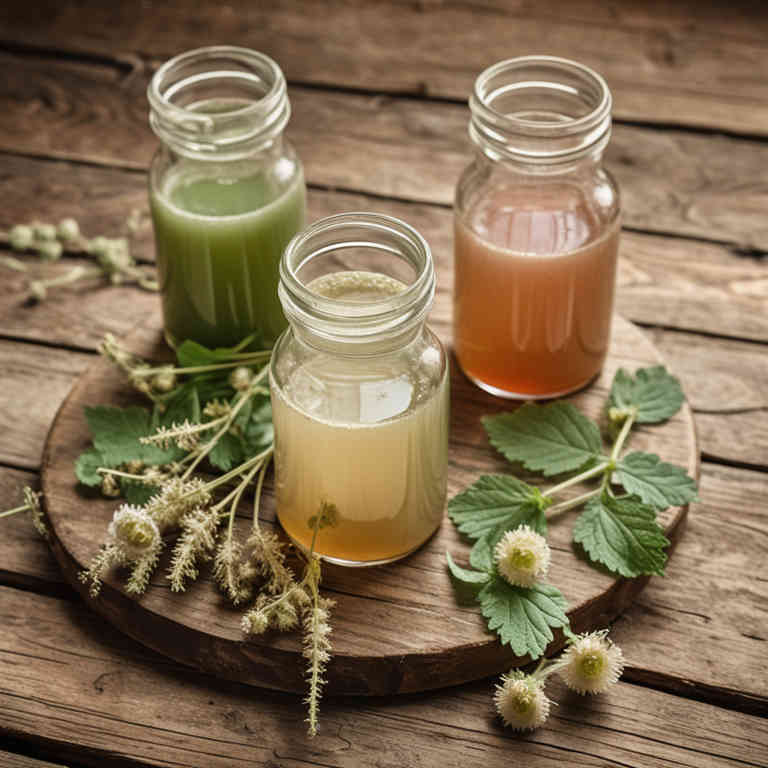
Althaea officinalis herbal juices are used to soothe respiratory conditions due to their mucilage content, which helps to loosen mucus and reduce inflammation in the airways.
They are also commonly used to alleviate symptoms of coughs and sore throats because of their demulcent properties that coat and protect irritated tissues. Additionally, these juices may support digestive health by acting as a mild laxative and promoting healthy bowel movements. The anti-inflammatory and antimicrobial effects of althaea officinalis make it beneficial for skin conditions and wound healing when applied topically.
Overall, the versatility of althaea officinalis herbal juices makes them a valuable natural remedy in both internal and external applications.
84. Cimicifuga racemosa
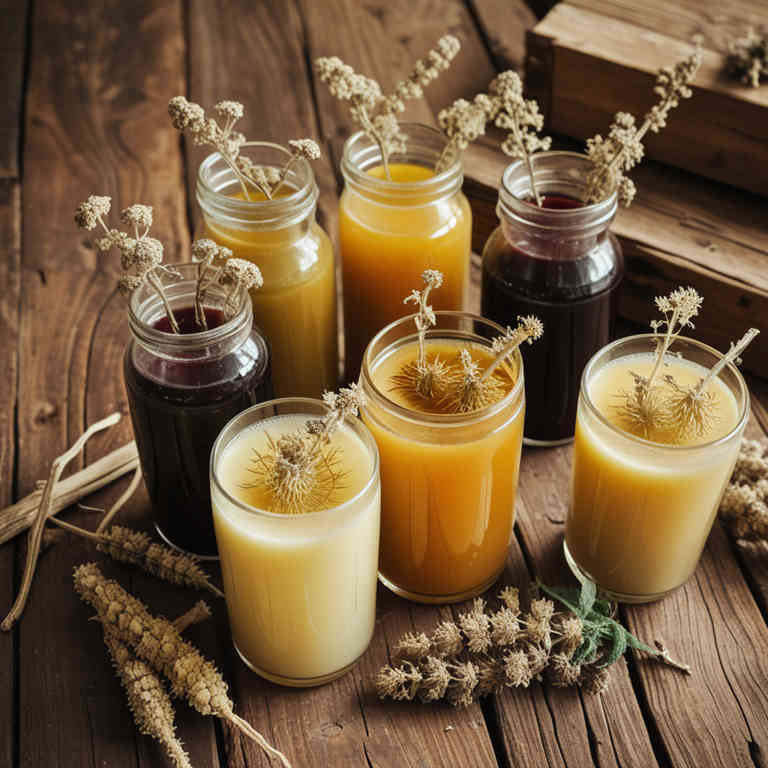
Cimicifuga racemosa herbal juices are used to support women's health, particularly in alleviating symptoms of menopause such as hot flashes, mood swings, and sleep disturbances.
These juices are believed to contain compounds that help regulate hormonal imbalances, making them a popular alternative to hormone replacement therapy. Additionally, they are used to reduce inflammation and ease joint pain, which can be beneficial for individuals suffering from conditions like arthritis. The plant's roots and rhizomes, often used to make the juice, are rich in phytoestrogens and other bioactive substances that contribute to its therapeutic effects.
Due to their natural composition and potential for fewer side effects compared to synthetic treatments, cimicifuga racemosa herbal juices are increasingly sought after in complementary and alternative medicine.
85. Citrus sinensis
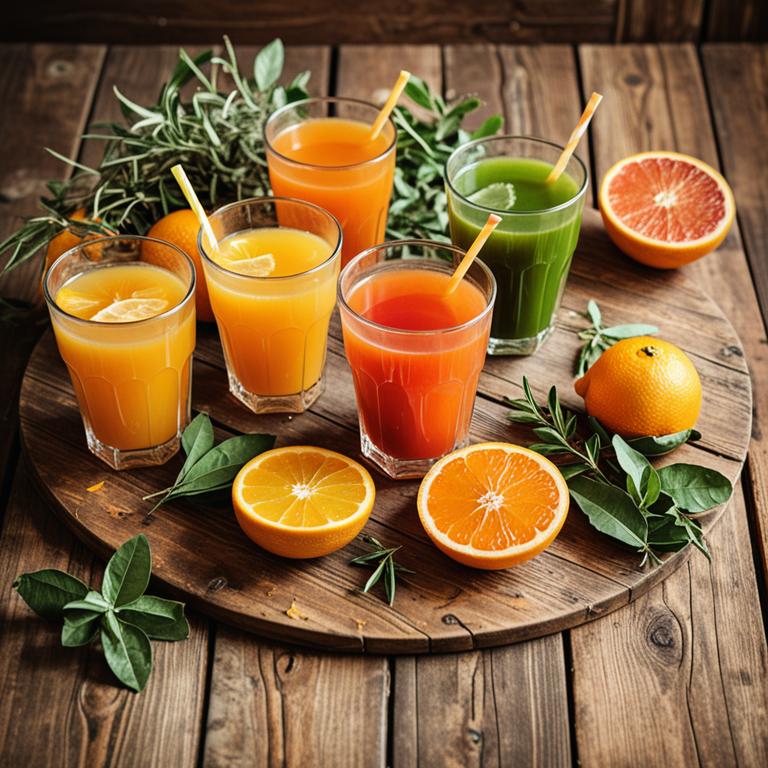
Citrus sinensis herbal juices are used to enhance digestion and promote overall digestive health due to their high content of enzymes like papain and bromelain, which aid in breaking down proteins.
These juices are also valued for their ability to boost the immune system, thanks to their rich supply of vitamin C, which supports the body's defense mechanisms against infections. Additionally, citrus sinensis herbal juices are used to improve skin health by acting as natural antioxidants that help neutralize free radicals and promote a clearer complexion. They are often incorporated into herbal remedies to alleviate symptoms of colds and respiratory issues, owing to their decongestant properties.
Finally, these juices are used to support metabolic functions and may help in managing conditions like diabetes when consumed as part of a balanced diet.
86. Aegle marmelos

Aegle marmelos herbal juices are used to promote digestive health due to their rich content of enzymes and nutrients that aid in the breakdown of food and absorption of nutrients.
These juices are also beneficial for liver function, as they help detoxify the body and support the liver's natural cleansing processes. Additionally, they are known to have antimicrobial properties that can help combat infections and boost the immune system. The presence of antioxidants in aegle marmelos juices contributes to reducing inflammation and preventing cellular damage, which can lower the risk of chronic diseases.
Overall, these herbal juices are valued for their holistic health benefits, making them a popular choice in traditional and modern wellness practices.
87. Cucumis sativus
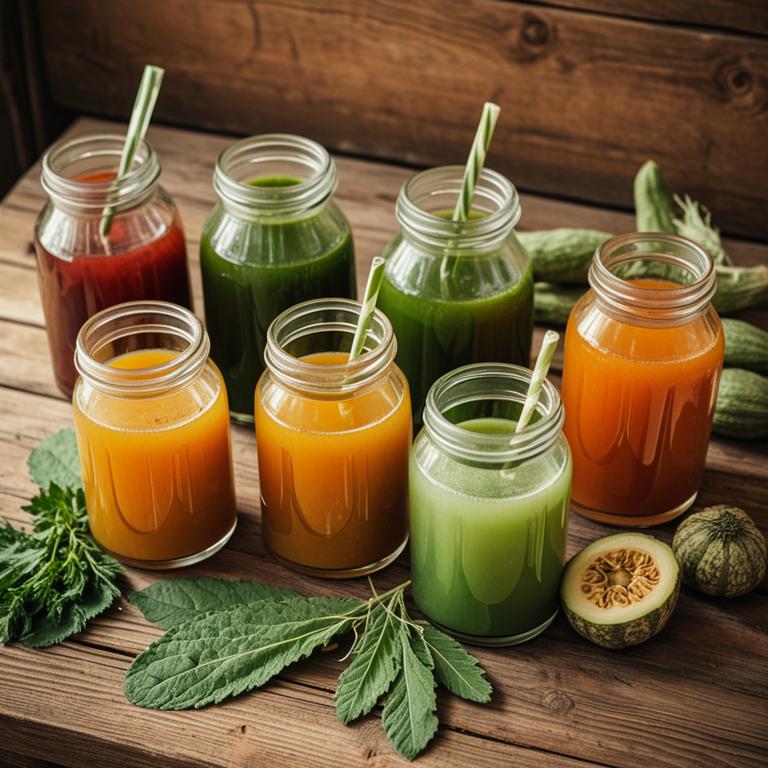
Cucumis sativus herbal juices are used to promote hydration and detoxification due to their high water content and natural diuretic properties.
These juices are also beneficial for skin health, as they help reduce inflammation and maintain a clear complexion. Additionally, they support digestive health by aiding in the relief of constipation and improving gut function. The presence of antioxidants in cucumber juice helps combat oxidative stress and boost overall immunity.
Overall, cucumis sativus herbal juices are a versatile and nutritious addition to a balanced diet, offering a range of health benefits.
88. Celtis australis

Celtis australis herbal juices are used to support digestive health due to their mild astringent properties that can help regulate bowel movements and reduce inflammation in the gastrointestinal tract.
These juices are also valued for their antioxidant content, which may contribute to overall immune support and cellular protection. In traditional herbal medicine, they have been employed to treat mild digestive disorders and promote a sense of well-being. The natural compounds in Celtis australis may also aid in detoxification processes within the body.
Overall, the use of these juices reflects a holistic approach to health, emphasizing natural remedies for common ailments.
89. Eclipta prostrata
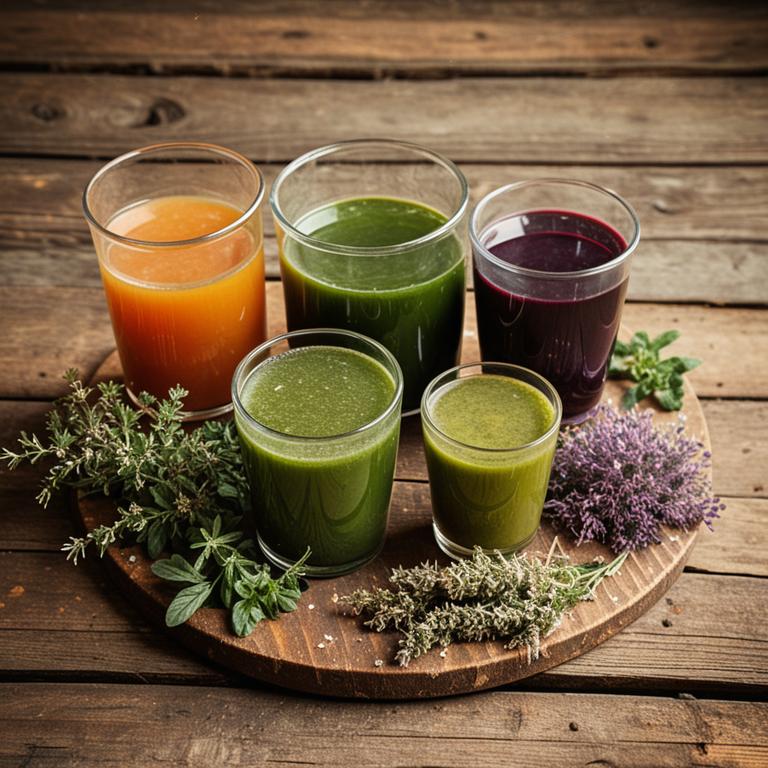
Eclipta prostrata herbal juices are used to promote hair growth and improve scalp health due to their rich content of antioxidants and essential nutrients.
These juices are believed to stimulate the hair follicles, leading to stronger and healthier hair. They are also used in traditional medicine to treat skin conditions and reduce inflammation. The presence of compounds like flavonoids and vitamins contributes to their therapeutic properties.
Overall, eclipta prostrata herbal juices are valued for their natural ability to support both hair and skin wellness.
90. Cucurbita pepo
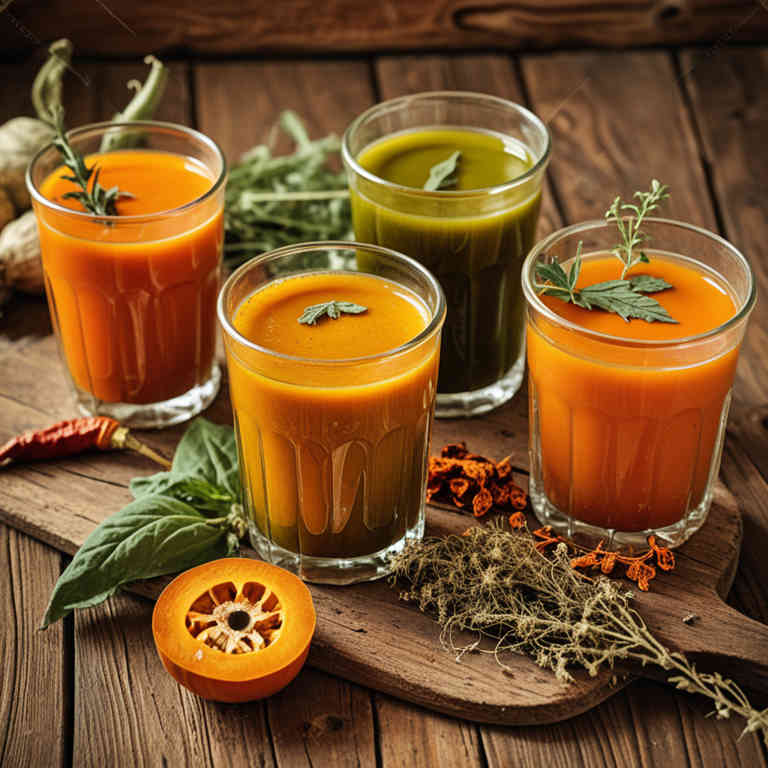
Cucurbita pepo herbal juices are used to support digestive health due to their high content of enzymes and nutrients that aid in digestion and nutrient absorption.
These juices are also valued for their anti-inflammatory properties, which can help reduce inflammation in the body and alleviate symptoms of conditions like arthritis and digestive disorders. Additionally, they are believed to boost the immune system by providing essential vitamins and antioxidants that combat oxidative stress and support overall wellness. The natural detoxifying properties of cucurbita pepo juices make them popular in cleansing regimens aimed at improving liver function and overall metabolic health.
Because of these benefits, they are widely used in traditional medicine and holistic health practices to promote both physical and emotional well-being.
91. Origanum vulgare
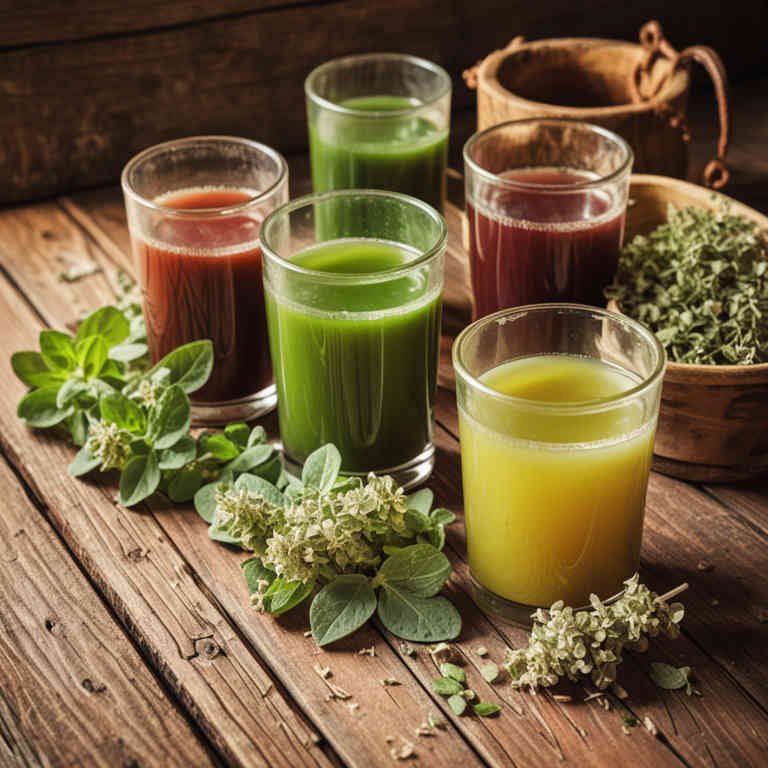
Origanum vulgare herbal juices are used to support digestive health due to their high concentration of antioxidants and anti-inflammatory compounds.
These juices can help alleviate symptoms of indigestion, bloating, and stomach discomfort by promoting healthy gut function. They are also known to have antimicrobial properties that can aid in fighting harmful bacteria in the gastrointestinal tract. Additionally, the essential oils in origanum vulgare contribute to its ability to reduce nausea and improve overall digestive efficiency.
Because of these benefits, origanum vulgare herbal juices are increasingly popular in natural remedies and holistic health practices.
92. Piper methysticum
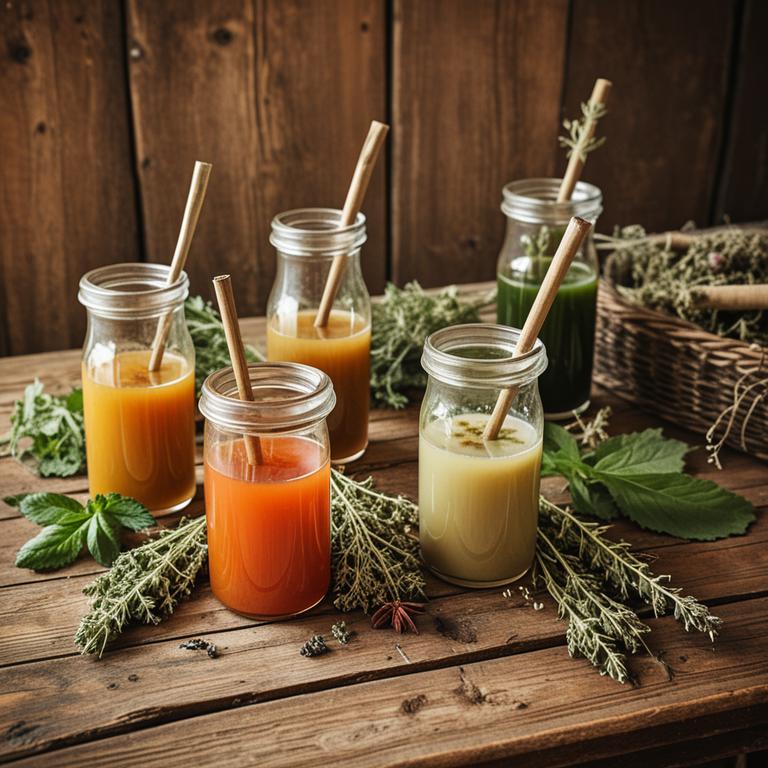
Piper methysticum herbal juices are used to promote relaxation and reduce stress by interacting with the central nervous system to induce a calming effect.
These juices, commonly derived from the kava plant, are traditionally consumed in ceremonial and social settings to foster a sense of community and well-being. They are also used to alleviate anxiety and insomnia due to their mild sedative properties. The active compounds in piper methysticum, such as kavalactones, contribute to its ability to modulate neurotransmitter activity, enhancing mood and emotional stability.
As a result, these herbal juices have gained popularity as natural alternatives for managing mental health and enhancing relaxation without the use of pharmaceuticals.
93. Orthosiphon stamineus
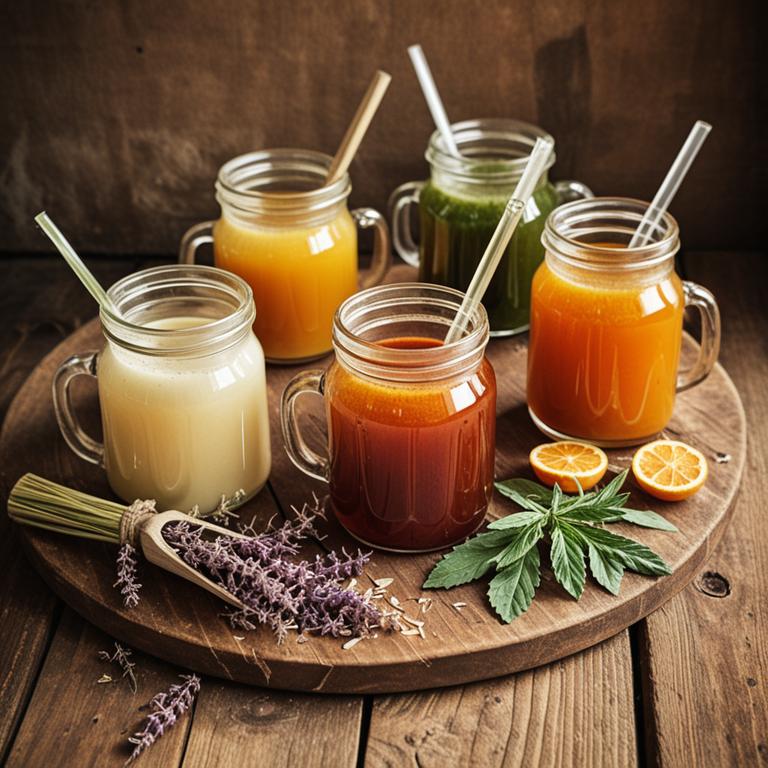
Orthosiphon stamineus herbal juices are used to support kidney health by helping to reduce excess uric acid and promote the elimination of toxins from the body.
These juices are also beneficial for individuals suffering from urinary tract infections due to their antimicrobial and anti-inflammatory properties. Additionally, they are known to aid in the management of diabetes by improving insulin sensitivity and lowering blood sugar levels. The high concentration of potassium and antioxidants in the juice contributes to its role in reducing inflammation and supporting overall metabolic function.
Because of these health benefits, orthosiphon stamineus herbal juices are increasingly being incorporated into natural remedies and dietary supplements for a variety of health conditions.
94. Nasturtium officinale

Nasturtium officinale herbal juices are used to support digestive health due to their mild anti-inflammatory and antimicrobial properties.
These juices can help alleviate symptoms of indigestion, bloating, and stomach discomfort by promoting the production of digestive enzymes. They are also valued for their ability to detoxify the liver and support the immune system through their high concentration of vitamins and antioxidants. Additionally, the peppery flavor of nasturtium juice can stimulate appetite and aid in nutrient absorption.
Because of these benefits, nasturtium officinale herbal juices are often incorporated into natural remedies and wellness regimens for overall vitality.
95. Cannabis sativa

Cannabis sativa herbal juices are used to support a variety of health and wellness goals, including reducing inflammation, alleviating pain, and promoting relaxation.
These juices are often consumed for their potential therapeutic properties, which may stem from the presence of cannabinoids like CBD and terpenes that interact with the body's endocannabinoid system. They are also popular in alternative medicine practices for managing stress, anxiety, and sleep disorders. Additionally, some people use cannabis sativa herbal juices as part of a holistic approach to improving overall well-being and vitality.
The versatility of these juices makes them a subject of ongoing research and interest in both traditional and modern health contexts.
96. Santalum album
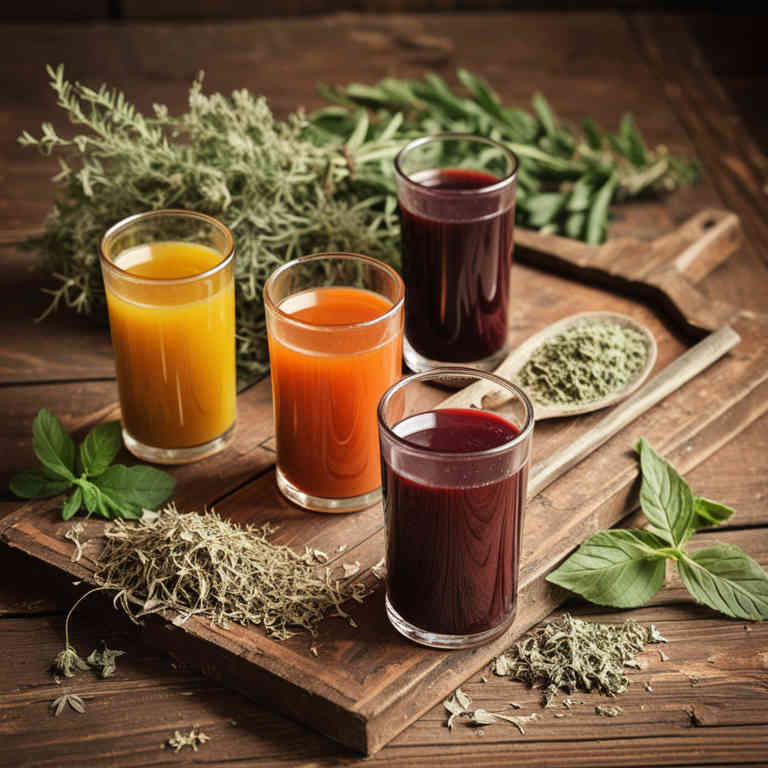
Santalum album herbal juices are used to promote skin health and enhance overall well-being due to their rich composition of antioxidants and essential nutrients.
These juices are known to support skin hydration, reduce inflammation, and improve the skin's natural glow by nourishing the epidermis. Additionally, they are valued for their calming effects, making them beneficial for stress relief and promoting a sense of tranquility. The unique blend of phytochemicals in santalum album helps in detoxifying the body and boosting immunity.
As a result, these herbal juices are increasingly popular in both traditional and modern wellness practices for their holistic healing properties.
97. Achyranthes bidentata

Achyranthes bidentata herbal juices are used to support kidney health and promote urinary tract function due to their diuretic properties.
These juices are also valued for their ability to enhance joint mobility and reduce inflammation, making them beneficial for individuals with arthritis or other musculoskeletal conditions. The herb's rich content of saponins and mucilage contributes to its effectiveness in detoxifying the body and improving circulation. Additionally, achyranthes bidentata herbal juices are believed to aid in the treatment of hemorrhoids and other gastrointestinal issues by strengthening the vascular system.
Overall, the diverse therapeutic properties of this herbal juice make it a valuable remedy in traditional and complementary medicine practices.
98. Tussilago farfara

Tussilago farfara herbal juices are used to soothe respiratory ailments such as coughs, bronchitis, and asthma due to their expectorant and anti-inflammatory properties.
These juices help loosen mucus in the airways, making it easier to expel and reducing irritation in the respiratory tract. They are also known to have a calming effect on the lungs, which can alleviate symptoms of persistent respiratory conditions. The plant, commonly known as coltsfoot, has been traditionally used in herbal medicine for centuries because of its rich content of mucilage and flavonoids.
Overall, tussilago farfara herbal juices are valued for their natural ability to support respiratory health and ease breathing.
99. Coriandrum sativum
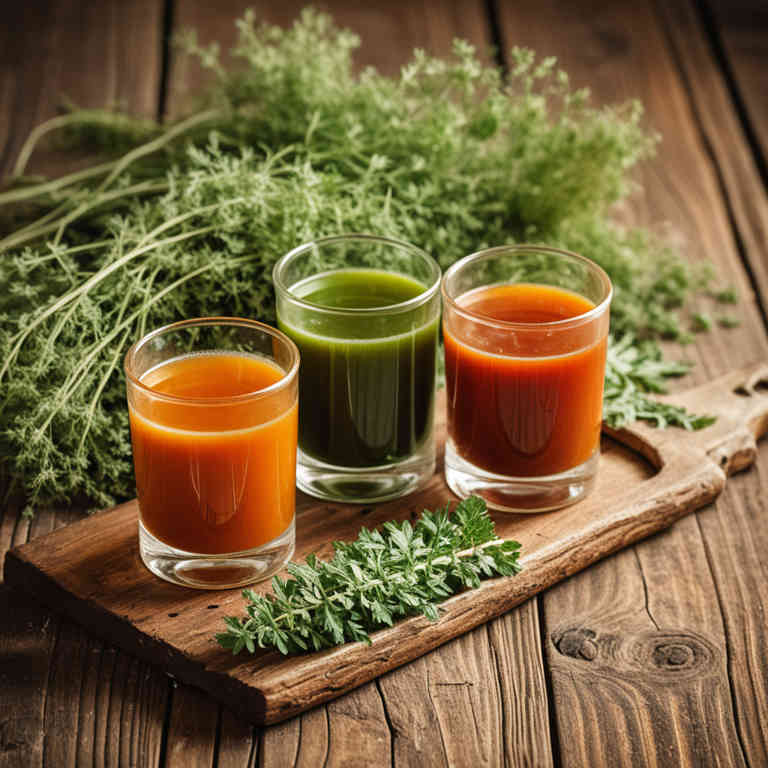
Coriandrum sativum herbal juices are used to support digestive health due to their high content of essential oils and antioxidants, which can help alleviate bloating and promote regular digestion.
These juices are also valued for their ability to reduce inflammation, making them beneficial for individuals suffering from conditions like gastritis or irritable bowel syndrome. The presence of vitamins A and C in coriander juice contributes to its immune-boosting properties, helping the body fight off infections more effectively. Additionally, coriander juice is known to help lower blood sugar levels, making it a useful natural remedy for those managing diabetes.
Overall, the combination of these health benefits makes coriandrum sativum herbal juices a versatile and valuable addition to a holistic wellness routine.
100. Bacopa monnieri
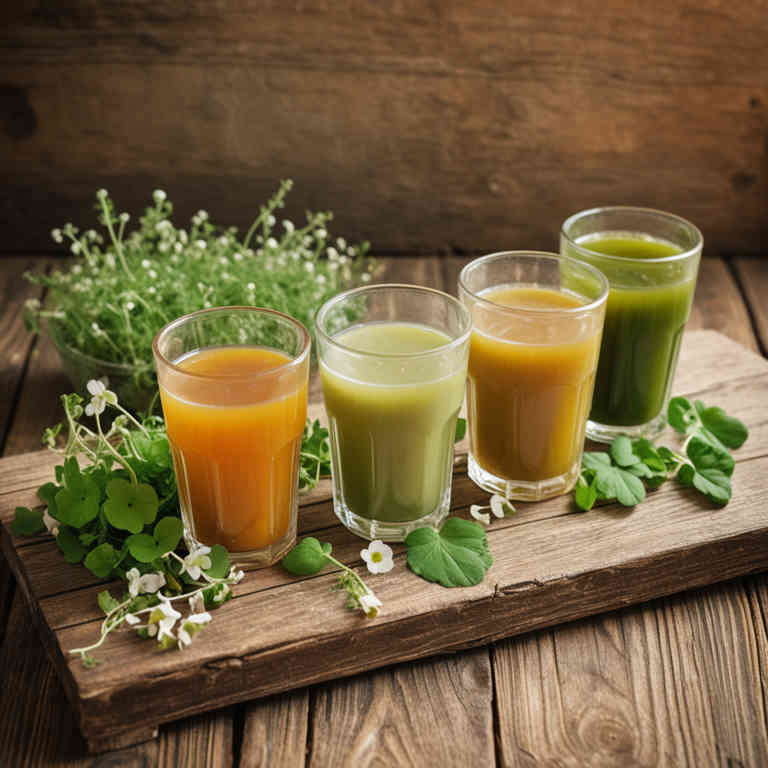
Bacopa monnieri herbal juices are used to enhance cognitive function and memory retention, making them popular among students and professionals seeking mental clarity.
These juices are believed to support the nervous system by promoting the growth of nerve cells and improving synaptic transmission. They are also utilized in traditional Ayurvedic medicine for their calming effects, helping to reduce anxiety and stress. The active compounds in bacopa monnieri, such as bacosides, are thought to contribute to these cognitive and neurological benefits.
Due to their potential to improve focus and reduce mental fatigue, these juices are increasingly incorporated into modern health and wellness regimens.